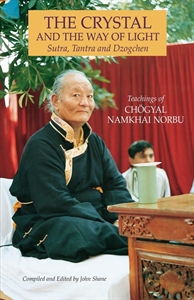
水 晶与 光 道
经、续与大圆满
南开诺布 教授约翰谢恩 编辑
孙一 译汉
TheVoidOne审校新加坡仁钦出版社
声明:本《水晶与光道》简版仅供对南开诺布仁波切大圆满教法感兴趣者阅读,禁止外传。
本书回向给我的上师持明蒋秋多杰我的两位舅、伯多登邬金旦净钦哲措基汪葵
和一切众生的利乐 ——南开诺布
目录
III编者序
V译者序
VII六句金刚偈
1 第一章 我的出生、早期生活和教育及如何与我的根本上师相遇
13 第二章 大圆满与西藏文化简介
18 第三章 我的上师蒋秋多杰如何显示直指的真义
29 第四章 大圆满与其他佛法诸乘的关系
50 第四章 我的两位大圆满大师的舅父和伯父
62 第六章 基
81 第七章 道
125 第八章 果
151 附录一、镜子
168 附录二、著作者传略
175 附录三、界部
178 南开诺布上师著作
180 大圆满同修会联络处
Namo Guru Bhy! Namo Deva Bhy!
Namo Dakini Bhy!
正如同太阳升上天空,同样地,愿一切胜利者的伟大秘密宝藏--至极的大圆满教法升起并传布至一切界!
(上方的白色的字母“阿”,是心之本来的状态的标志;其下方是向上师、本尊、空行三根本敬礼;最下方是莲花生大士对大圆满法的敬愿文。胜利者所指的是已经克服了二元状态的众生。)
编者序本书的内容包括从近七年南开诺布上师在世界各地举行的法会和讲座中所做教学的录音带中腾写出来的资料,也包括在一些未录音的开示中我本人所做的记要以及我与上师在私人谈话中得到的资料。
虽然上师的英文很好,然而直到一九八四年以前,我都一直喜欢用他最熟悉的意大利语来教学。他通常每说几句便停下来供翻译者译成大多数听众能懂的语言。如在意大利,将意大利文译成英文,以便利不懂意大利文的听众。是故这本书的完成应归功于所有翻译,录音和腾写仁波切教法的人。虽然与弘法同时的现场口头翻译也常有自然性的好处,然而若印成书,则有缺简练。
因此编者最主要的工作点便是将所有的资料整理成通顺的英文。然而更大的一件工作是如何从许多讨论各种不同主题的腾本中策划出全书的形貌以显出教法整体的固有结构,而无损于上师口传教学的风格。我处理的方式是将上师的教法和能有交显发此教法的上师有趣而富启发性的故事穿插在一起。本书的对象不只是针对学者而已,也针对一般大众。是故我尽量避免使用太多的附注。若是我的编辑工作有任何成功之处,都应归于上师的耐心,他不断地抽出时间,私下向我做进一步的解释和说明。至于书中或有任何残余差错皆我个人的责任。有太多朋友在这项工作中帮忙,以致无法将他们的名字尽皆列出,不过我要特别感谢我的妻子周对我不变的支持和鼓励。
于此人性危机迫近之时,当务之急莫过保存清楚地理解古代智慧的传统,因为它们能引导吾人转化,对社会的和平转化贡献伟大,未来人类和地球的生存有赖于此。与南开诺布上师合作完成这部著作的确是我享有的最大的恩典,不论这本书的力量有多大我由衷希望它能为终止一切众生的争斗与不和以及增长众生的各平自由真实有所助益。
读者亦复应知任何书籍皆不能取代具德上师处获得的传授,愿所有尚未得到这样一位“道友”的人,有幸寻到。
愿吉祥!
约翰谢恩
阿西德索一九八五年六月译者序
这本书是经由台北郗家骏居士的介绍,和仁钦出版社的资助而译的。因为我只一眼已以失明,有一眼有视力而且眼力不佳,又刚从台北南来休养,故当时并没有决定立刻译。但在读了本书之后,深感教法太好,把大圆满说得这么清楚的书以前未曾见过,以往一些见地上的疑问,也获解决,乃决心开始译。但因健康关系,也只想能译多少,就译多少而已。在翻译过程中,常感疲劳,几次想到放弃,后来终于下决心放弃了,就在那天下午起了大雷雨,雷电交加前所未有,而且闪电就打在屋子的前面,震撼异常,我心想也许是护法的示现吧!应该再坚持下去才是,于是又开始慢慢译。又曾在翻译期中某日,梦中于佛堂内静坐时,自念书中的六句金刚偈,而身浮起,至一人高,而后渐渐落下而醒,心中很欢喜,知是上师三宝加被,应当应尽力坚持译下去,最后用了两年时间,终于译成。因为本人一向毅力薄弱,若非上师三宝如此警策、加持,绝对译不完的。谨在此志恩也。愿所有读者信心喜悦增加。
索甲仁波切在他的《西藏生死书》中提到一美妙预言:「在此黑暗时代,普贤王如来的心要(大圆满)将像火般地照耀。」而他的生命教法和书皆是点燃世间众生心中的这把火。相信南开诺布仁波切的这本《水日与光道》也必能在此大因缘会中贡献出应有的力量,点燃众生的心灯。而我的翻译若有任何的功德,亦愿悉皆回向此一大事。
孙一于台湾南投一九九七年三月
万物本体虽无二远离琐碎之戏论真相虽然不可思乃是普明普贤佛应断造作之弊病自然安住便是定
六句金刚偈注
此六句金刚偈将大圆满教法完美地摘要出来,此翻译是由吐登上师 Zenkar Rinpoche Thubten Nyima由藏文直译的。上面是由南开诺布上师所写的六偈之藏文的草书。本书的的主要章节可被视为此六句偈的诠释,而此六句偈则是《不二觉知的致福杜鹃续》Draxisbai Pal Rigbai Kuyug Tantra的内容。因为杜鹃是来年春天的第一位报信者,是故本续和这些偈子则是将来心灵觉悟的预报。
我的出生、早期生活和教育以及如何和我的根本上师相遇。
从最起始,一切无量众生既以觉者的圆满清净状态为其本性,而我也不例外,是故我将献身究竟觉。
龙钦巴尊者(1308—1363)所写的菩提心文,叙述阿奴瑜伽中对《基》的观念。
我于地虎年十月十七日(一九三八年十二月八日)生在东部西藏德格的宫拉地区一个名叫格吾的村庄里。据说虽然是冬季时令我双亲屋外的玫瑰花却盛开了。我的两位舅伯立刻来访,他们皆是大圆满的大师,过去者曾是阿宗珠巴 Adzoma Drugba大师的弟子。这位大师几年前逝世了,而他们坚信我就是他们上师的转
世,因为这位大师在去世前曾和他们说过一些事情,也因为他曾将某些特殊的遗物赠给我双亲的那位将在他去世后诞生的儿子。
二岁时,我正式被认证为一位宁玛巴派高级活佛Tulku的转世,我得到了一些法袍为礼物。我对当时的种种细节已记忆不多,不过我确知事后我得到非常多的礼物。
后来当我五岁时,被十六世噶玛巴和当时锡杜上师认证为另外一位大师的心转世而这位大师则是现代不丹国创始者的转世。他的传承是延续直至二十世纪初期的当世的俗权与教权的统治者。因此在我成长的过程中,被取了许多名字和荣衔,它们大多很长而且听起来很伟大,然而我却从来未使用它们,因为我最喜欢的是我双亲在我出生时给我取的名字。他们叫我南开诺布Namkhai Norbu,这是个很特殊的名字。「诺布」的意思是如意宝珠,南开则是「天的」或者是「空的」。这样以所有的格的方式来命名在西藏是稀有的。至于为何取了这么一个名字是因为当时我的父母虽已有了四位很好的女儿,他们想求一个儿子,已想了好多年了,他们的愿望非常的强烈,以致于为了此事而供养一位出家的僧人一年之久,由他做他们的代表向度母祈愿(请看图解和第四页注释)。这位僧人也成了我姐姐们的教师。最后他终于得到了一个很好的梦兆,他梦到一株美丽的植物从我父母亲家中的炉床的正前方生出来。这棵植物开出一朵美丽的黄花而且长得很大,这位僧人认为这是必生儿子的征兆。我出生后,双亲非常的欢喜,觉得这是上天所赐的,所以他们叫我「天之宝」,这便是我固用的名字。
父母对我总是非常的慈爱,我逐渐长大,和其他小孩子一样很淘气,并在家里学习读书和写字。小时候我经常梦到自己乘坐在一只似乎是老虎(对当时的我而言。一只奇异的吼哮动物)之中飞速穿行,那时我从未见过汽车,因当时我的家乡没这东西。当然后来我常乘汽车旅行,认出他们即是过去我梦中所见到的。
在我十几岁时,我第一次看见一部卡车,那是某天的晚上我骑马
GreenTare 绿度母
绿度母是法身阿弥陀佛所化之女身报身佛,共有二十一种不同之显现,每尊度母均是慈悲心以不同的方式之体现。绿度母代表慈悲心的积极的、救度的、活力的一面,她也是西藏的女护法。而白度母,则是慈悲心的增长满愿之显现。
在山边向下眺望,看见在新中国公路上通过的汽车。呼啸而行的大卡车的红色尾灯,令我以为是失火了,我也曾梦到奇异的带着火焰的飞行物爆炸且造成可怕的伤害,如今我知道当时看到的是飞弹,正在远处世界他方发展中。所幸直到目前为止我尚未在醒着的生活中见到我童年时梦中所见的战争。
我有时喜欢和邻居们恶作剧,但当父亲回来时我就麻烦了,他会打我,父亲因工作关系经常在外旅行。他若打我,我会很生气,于是会对父亲告状的邻居玩更多的恶作剧以为报复。当然后来我就更麻烦了。我受祖母的影响很大,她曾是阿宗珠巴大师的弟子,故对我很感兴趣,她有时会对我向父母隐瞒我所做的事以免被他们处罚。记得有一次,我找到一只大山拨鼠的尸体独自和这只死动物愉快地玩了一下午,我甚至将尸体装满水后在头上旋转。但当我将它带上床床准备睡觉时,被祖母看到了。他知道倘若这件事被我母亲知道,必定令她非常的烦恼,且会担心我受到疾病的感染,所以她没有告诉任何人。因此我觉得她非常的仁慈。并深爱她。后来当我看到她因为我的行为而暗自哭泣时,(那时她以为我已入睡),我大受感动,于是决心痛改顽皮的作风。然而,我也不敢说完全成功地克服了这个顽习。
五岁时某天当我在屋外玩耍的时,来了十二位僧人,他们穿着高雅,我们的住处与外地隔绝。很少有行旅通过,因此他们的来访令我很惊讶,我也不知道他们为何而来,他们进入屋子后不久叫我也跟着进去。我被带进那间小佛堂,他们为我穿上美好的丝袍,我不知道为什么他们给我穿这个衣服,然而我还是享用了。我又坐在他们特别为我准备的高座上数小时之久,他们刚在作某些仪式,而后离去。我心想“啊!这下事总算结束了!”然而每个人都在提醒我,我是一位转世并对我表示极大敬意,于是我立刻领悟到这远非任何事情的结束,其实一切才开始呢!
数周后,几位僧人来了将我带到德格宫千寺Dege Gonqen Monastery。此寺在该地区非常重要,因为德格国王就居住于此。父亲在国王的政府工作,起初是相当于西方的市长或省长之类的官员,后来因为他热爱动物乃改任保护动物组织的领袖,该组织是防止该区非时和过量地捕杀动物,我被引入晋见国王,因为我已被认证为转世者,他乃把寺院中的一幢房子赠送给我。我便在那儿和一位老师同住到九岁。这位老师教我昼夜精勤的学习,要学的内容实在很多,包括寺庙中全部的规矩和祈祷文,所学的内容一般僧人大约十九岁时方能完成,而我在八岁时就全部学完了功归于在老师之严格监督下,我几乎毫无自由时间。此外,我天赋的记忆力也非常的强。然而我顽皮的一面却也不时地会冒出来。譬如,我记得某次国王举行阅兵大典,他必须在庭院中静静地骑在马背上相当长一段时间,而他的位置恰好在我房子一楼窗户对面,于是我靠在窗台上用一面镜子将阳光反射到他眼中令他目眩,使他在此略带严肃气氛的场合中分心。所幸当时国王已经对我十分的了解,在他恢复镇定后,居然对我玩弄的把戏颇欣赏。
然后有一年的时间我学习所有的坛城Mandala绘画和修学的规则。而后。我就离开该处前往佛学院就读,每所学院都有它的规矩,我所就读的佛学院必须在该处修学五年,但因我入学的年龄太早,所以我共在学院学了六年,一般入学的年龄是至少十三岁,而我往常时才九岁,所以我在那儿的第一年,他们没有算,只当做是一种测验,看我能否承担其课业。这儿的功课不再只是记忆而已,我们学习哲学故必须有很好的论理能力,有许多学生觉得太困难而退学了,当然对我这样的年龄来说,学院生活也不经常是那么轻松的,我和其他同学都尝到这种学院生活的严苛的滋味,我必须很快速地学习许多惯用的功课。当我在学院就学的第一学期,父亲给我足够该学期三个月的生活所需,但因我过去从不需要自行处理生活所需,以致学期一半时就将生活费用完了,因为我对所有的新同学过于慷慨,后来当我没有食物时,只喝茶大约过了一个礼拜,因学院只供应茶水,而后我才低头向我的老师求助,他为我安排每天黄昏可得到一碗汤,所以到了第二个学期。我对于生活物质就慎重多了。
学院的规矩非常的严格,每晚我们都必须在自己的小屋中修学,酥油灯和烤火的煤炭,由学院供应,但份量并不充足。记得有一次我的油灯点完了而需要读的功课尚未完成,这些功课是我在接受许多灌顶发愿每晚要念诵的。学院的规矩我们在那个时间不许离开房间,并且有一位僧人在走廊上巡逻执行任务,所以我不敢出来向邻房借灯,我只好用炭火的光来读诵,因对其中某些部分所知甚熟,枵直读到炭火仅剩余尽之微光。但后来最后的一点微光也消灭了,此时我完全落入黑暗中,然而为了要持守我的三昧耶 Samaya,仍有一大叠冗长的西藏经文待念,当时我不了解应如何摘取修学的重点来护守三昧耶,对所学教法的理解和执行都是很字面的。
假日时,我则有空去探访舅伯二父,拜访他们对我来说非常的重要,因为他们都是大圆满的大修行者,一位住持,另一位则是瑜伽士。我将在本书后面解释教法的各章中谈一些我实际经验的有并他们的故事。在我读佛学院的数年中,他们对于我尤其重要,因为他们都是实修者,故成为我这段期间(九岁至十六岁)以学识研究为主的平衡力。西元一九五四年当十六岁时完成了佛学院的教育,我知道许多各种形式的教法,并学习了西藏医学和占星术,我能背诵整个的哲学教本和仪轨,我曾随许多上师精进学习,并曾在学院中教授一些课程,似乎我已对一切都了解得够好了。然而,后来我才觉悟到,当时我未曾真正了解到。
虽然那时我还不知道,命运却已将我带向另一位特殊的上师,他将把我所学和所体验以的一切带入一个更新更深奥的境界。
由于和他的接触,我将再觉醒并真正了解大圆满法。经由他的启发我了解了大圆满教法的重要,后来并在西方传授此教法,这位上师并非什么显赫的人物,西藏人通常喜欢高阶位的有名上师,他们大都表现得很堂皇,因为若无这种外相,一般人通常无法了解上师的功德,而我本身也不例外。离开佛学院后,我第一次担任公职,被派到中国的四川省当省议会的西藏青年代表,在那我一面教藏文一面学中文,故相当忙碌,同时,我注意到那儿与西藏截然不同的社会和政治结构,并怀疑在中国发生的种种终将影响我的国家和人民。某晚我做了一个梦,梦中我看到某地有许多水泥建造的白色的房屋,其形式不是西藏而是中国式的,因此我误认房屋是属于汉人的。仍在梦中,我走近这些房子,发现其中某幢屋子上竟写着斗大藏文字母的莲师咒,我感惊讶,若这是汉人的房子,为什么会在门上写着藏文的咒语呢?我打开门走近去看见里面有一位老人,只是一位看起来很普通的老人于是我想“他可能真的是一位上师吗?”这时他将向弯下,以额头触我的额头,以这种西藏上师赐予加持的方式来加持我并开始念莲师咒,这些都令我感到惊讶,然而此时我已确信他是一位上师。然后,这位老人叫我到旁边一块大岩石的另一边去,并说在岩石中间我会发现一个藏有八个天然坛城的岩洞,他说我应该立刻前往该处观看。他所说的令我更觉吃惊,但我还是立刻前去了,当我到达岩洞时父亲出现在我后方,我进入岩洞后,他开始高声的念诵《般若波罗密多经》(一部重要的大乘的经典),于是我也跟他一起念,然后我们一齐在洞中走动,我无法见到八个坛城的整体,只能看到它们的角和边,就当它们还在呈现在我心中时,梦醒了。
一年以后,我已回到西藏,某日有人到村庄来拜访我的父亲,我无意中听见他和父亲谈到一位他刚刚遇到的非常特殊的医生,他描述了这位医生的住处和个人细节,于是令我忆起了这个梦。我敢肯定他所描述的这位医生,就是我梦中所见的老人,于是我将自己的看法告诉父亲,令他也回忆起这个梦,因为在做该梦不久后,我曾将梦的内容告诉他。然后我请求父亲和我一道去探访这位医生,他同意了。我们第二天便出发。骑马走了四天才到达。到达后我发现这位老人的确似乎就是梦中所见的,且的确感到过去曾来过此村庄,以水泥建造的中国式的西藏房子,门上写有咒文,所以我毫无疑问地认为他就是我的上师,并留在该处依他受教,这位上师的名字是蒋秋多杰 Chanchub Dorje。从外表看来他就像一位普通的西藏乡下人,他的衣著和生活方式在表面上看来都非常普通,然而在本书中我会进一步谈到关于他的种种事迹,将显示他的存在状态远不平凡。他周围的弟子们也过着很平淡的生活,他们大都是很简单的人,根本不富裕,种植谷类维生在田间工作并一起修行。蒋秋多杰是一位大圆满的大师,而大圆满是不依赖外界的,它是一种关于人类状态本质的教法。所以后来当我因西藏的政治动乱而离开该处,在西方定居并于意大利的那不勒斯大学东方学院 Oriental Institute of the University of Naples担任教授后,我发现虽然人们生活的外在环境和文化与西藏的有所不同,然而每一个人的基本状态却无不同。因为我看到大圆满教法并不依赖文化,故它可以在任何文化背景下教导,了解和修学。
若将大圆满授予一百位对它感兴趣的人,那亦不为多;若将它只授予一个对它不感兴趣的人,那已是太过人过分了。
当今许多人对心灵(精神)事物丝毫不感兴趣,这种现象被目前偏重物质和外观的社会所增强。你若问他们相信什么,他们可能会回答他们什么也不信。这类人认为一切宗教都只是基于信仰而已;这比迷信略好一些,但于当今世界并不 适切。但是大圆满并非宗教,也不要求人去信什么。然而,它要每个人观察自己,并发现自己的真实状态。
在大圆满教法中,认为人是在三个相互依赖的层面上运作着。此三层面即是「身」、「语」或「能」、和「心」。纵然某些人说他们什么也不信却不能说他们不信他们自己的身体,因身体是他们存在的根本 ,而其限制与种种问题也是明显地可确知的。譬如我们感到寒冷和饥饿,我们感到痛苦和寂寞,并且人们花费很多时间和精神来克服种种生理上的痛苦。
「语」或「能」的层面较不易见,也不被广泛了知,甚至西方的医生对它也非常无知,他们总想在纯物理的层次治疗一切疾病。然而,如果一个人的「能]」被干扰了,不论他的「身」或「心」皆无法平衡。某些疾病譬如癌症,就是由于「能」受到干扰形成的。并不能单靠外科手术或药物治疗治愈。相似地,许多心理疾病和一些不太严重的心理障碍乃是由于「能」的循环不良所致。我们的心通常非常 混乱和迷惑,纵然有时我们希望心能够静下来,但却做不到,因为紧张和激动的「能」令我们无法做到,所以为了处理这些身、语和心的种种困扰,大圆满教法提供了我们这三个层面的修学方法。这些修法能与个人的日常生活合一,并将我们紧张迷惑的生活经验转成教法。这不仅只是理论而已,而是很实际的。虽然大圆满教法非常 的古老,然而我们身、能、和心的本质未曾改变,所以这些教法能适用于今天的人类状态正如同它们能适用于往日的人类状态一样。
本来状态The PrimordiaI State
大圆满教法是一种关于众生「本来状态」的精要教法,所谓本来状态乃是每位众生从最开始以来的固有本性。进入了这个状态就如自己是宇宙的中心来体验自己一般——当然不是在一般自我(我执)的状态下。通常自我中心的意义正是二元观的有限牢笼,垄断了我们对自己真性,即「本来状态」的空的体会。了解此「本来状态」就是了解大圆满教法。而大圆满教法的传授就是从一位已经了悟它的人达成与此状态的沟通,或说将我们过去潜伏的自性显明,因我们过去被二元状态所关闭。大圆满的意思就是这个状态的本自圆满 Self-Perfectedness,,从一开始就根本清净,无一物可拒或可受。
欲了解并进入本来的状态我们并不需要学术文化或历史上的知识。尽其本性就是超越知识的。然而当人们听到一种他们未曾听过的教法时,首先想要知道的是此教法始于何地、从何处传来、由谁传下等等,这是可以了解的,但是大圆满本身不能说属于任何一个国家的文化。譬如有一部名为Dra Talgur Zavai Gyud 《声应成根本续》本说在我们这个太阳系外加有十三个太阳系上有此教法。所以我们也甚至不能法只属于我们地球,更不要说特别是哪个国家的文化了。虽然我们现在要讨论的大圆满传承的确传续于西藏文化中,其时间可溯自西藏有历史记载之始,然而我们不能下结论说大圆满是西藏的,因为本来状态本身并无国藉,它是无所不在的。
但是事实上各处众生皆已进入二元状态,因而封闭了对本来状态的体验。当觉悟者没法与他们沟通时,几乎无法完全不用文字或符号使他们明白本业状态,因此他们便 采用了所有当时当地的文化作为沟通的工具。由是之故文化和教法经常便交织在一起,而这种现象在西藏尤其普遍,几乎已经到了若不能了解教法则无法了解其文化的地步。
大圆满教法在西藏并非传布得特别广或特别的显赫,事实上正好相反:大圆满总是一种较保留的教法。此教法是所有西藏教法的精华,是如此直接,以致总是被保留得较隐密,而人们也常会对它感到有些害怕。此外,在古老的苯 Bon 教传统中,也有一个大圆满的传统。苯教是西藏本土的古老的宗教,较佛教从传入西藏更早。所以如果我们认为大圆满法是所有西藏精神传统的精华,包括佛教和苯教,(虽然实际上它本身不属于佛教亦不属于苯教),并且若我们认为西藏的精神传统是西藏文化的精华。那么我们便 可以用大圆满教法作为了解整个西藏文化之匙。以这样的眼光,我们会发现所有各种形式的西藏文化皆是精神传统中觉者们统一观的各面的显现。
无数觉者们内心「本来状态」的「明性」抛射出西藏艺术、图像学、医学、占星学等种种形象,如同在文化中心的一颗水晶,放射出璀璨的光芒或闪耀的光影一般。是故若能了解水晶本身的性质,那么对于从放射出来的光和芒将更易理解。
我的上师蒋秋多杰如何显示我直指的真义。
遁形;任何登上些最高山顶的人,不受任何人或事物的限制。
——大圆满某密续
当我去见我的上师蒋秋多杰时,在知识上来说,我已受教育至最高程度,心中充满了在佛学院中所学的一切,我以为若要得到此教法的传授 复杂的灌顶仪式是必要的,于是我要求蒋秋多杰传授我灌顶。我天天向他请求,但总是被他拒绝。“有什么用呢?”他说“你已从其他上师处得到许许多多这类灌顶,那样的灌顶在大圆满教法中并非主要的,传授并不只是在灌顶中才能得到。”但是不论他怎么说,我总是坚持要过去其他上师所授予我的那种仪式完美的灌顶。我对他的回答感到不满,我希望他戴上一顶特殊的帽子,准备一个坛城,然后在我头上洒一点水或者其它类似的事,那就是我真正虔诚祈求的,然而他总是拒绝。
最后由于我强烈地坚持,他终于答应了。他答应大约在两个月后的莲师日(藏历每月初十日)将传授我想要的,普贤如来和中阴寂静愤怒诸尊的灌顶。这个灌顶并不复杂,一位熟练的上师可以很快地完成。然而蒋秋多杰并未受过正规的教育,也不惯于传授灌顶。当这个我长久期待的日子终于到来时,他从早上九点开始直到午夜才将灌顶传完!首先,做自我准备,他需要做一个自灌顶,一直到中午他才做完。然后,他开始为我灌顶,但因未受过正规教育,他无法念 诵法本,此外,我发现他不会做仪式进行中他需要做的种种事;他不是那一类的上师。所以他找了一位弟子当助手。这位弟子本身在这方面则是专家,他准备了所有的坛城和仪式用品,首先这位弟子开始念诵法本,然后告诉上师他下一步应该做什么。但当他念 到上师需要做某个手印时,蒋秋多杰不知道怎么做,所以他必须再停下来教他。而后有一段很长的祈请文要唱诵,祈请所有传承上师,唱诵时,上师应同时摇铃击鼓,对这类仪式娴熟的人做起来是很快的,但蒋秋多杰对这些事完全不习惯,于是整个局面变得非常 的混乱,简直成了一场闹剧。首先,他要和助手弄清楚法本附注的内容。“啊”他说:“它说这儿你应该摇铃!于是他拿起了铃,一直不断地摇了五分钟。然后
他又念道:”现有你应该击手鼓!
“于是 Senrab Miwo 辛饶弥沃
此西藏上版画刻印的辛饶弥沃像,端坐于莲花座上,一手持着万字节杖,在苯教(BON)中相当于佛教之金刚杵,代表不可毁灭,常住的本初能量。
据最早可溯之史记之叙述,在公元前 1856 年曾出了一位伟大的苯教灵性导师辛饶弥沃,将当的苯教各派别综合改革,以塑像取代牲物献祭 ,并引入最早的大圆满教法(Yandagbai Sembon),此法不如噶饶多杰传授之三要义法之精细,Bon 苯一字的根本字义乃念诵,故此字引伸为念诵咒语或行宗教仪式。在史上,“苯教”并不以一独立的体系存在,有的是许多巫师传统之集成。而事实上,"Bod"一词与藏语对藏地之称 "Bon"由词源上追朔,可见这些传统与其发源地之根本联系苯教的修练可令行者超越二元,并掌握能之运作。
他拿起了手鼓又不断的击了五分钟。他突然,又说:啊现在我明白了!你应该摇铃并击鼓!”于是他又再这样做。然而这时他已经忘记应该唱诵 什么了。所以他又要靠能读的弟子帮助他从头再来一遍。蒋秋多杰本身没有受过那种学识式的教育,但他是一位修行者,经由自己的修持,显现了智慧和明性是故他是一位上师。于是他就这样绊绊跌跌地花了一整个白天和大半个晚上进行这个灌顶。当他完成此灌顶时,我几乎是休克状态,因为我确知灌顶应该如何做,绝对不是这样的。
然而这时已近午夜,大家都很饥饿,我们一齐唱诵金刚歌,(请看六十四页)多遍。此歌有一种、慢的,如赞美般的旋律,能引导行者与其音声合一而进入禅观,其音节之结构能令呼吸加深且放松,是大圆满仪式特有的方式。我们念诵一段简短的会供后,就开始用餐。饭后上师给我一个对灌顶和传授真义的真正解释,这时我方才了悟,虽然以往受过那么多的灌顶,却从未了解或进入它们的真义。
然后,毫不间断的,大约三、四个小时之久,蒋秋钦杰传授予我大圆满的真实诠释,不是用一种知识的方式,而是以一种非常 直接、轻松和善的谈话方式。虽然我受过那么多正规的教育,这却是我第一次一位上师以这种直接的方式企图让我了解一些事。他所说的和他所说的方式,就像一部大圆满的密续,自然并连续地高声说出。我知道纵使一位博学 的学者也无法那样说出来。他的讲述是从明性而生起 的并非知识的理解中说出来。从那天开始,以往我非常 看重知识研究便只有次要的价值了。我也 了解了传授的重心并不只是仪式或灌顶或知识的解说。那天我的思想建设完全崩解;直到那时为止,我都一直被关在佛学院中所说的种种的观念里。
传授在大圆满的导入中最为重要,那天我从蒋秋多杰所获得的直指,并在此后和他的相处中不断地获得,就是典型的大圆满教法师徒传授方式。此传承追源于第一位大圆满祖师噶饶多杰由他直接与报身佛接触而开始传下。
虽然较早于噶饶多杰的时代有一种较简化的大圆满教法曾被苯教的改革大师辛饶弥沃传入苯教的许多支派中。然而目前我们知的大圆满三部却是第一次在此劫于此地球由噶饶多杰祖师所传授。当然,后来的莲花生大师无疑地更为有名,然而他是从噶饶多杰获得传授的。传授的方式有二,一种是越过时空直接的净相传授,另一种就是一般的方式,因教法经由噶饶多杰的历代弟子们传续下来故。
噶饶多杰是一位完全的觉悟者。他于大约公元五十五年以化身出生人间,出生地点是位于印度西北的邬金国。他一世教导大圆满教义于人类和空行母,在他进入光身前的最后教法是将所有的教法归纳为三要义它们被称为「噶饶多杰三遗教」。
噶饶多杰不似释迦牟尼佛而像莲花生大师示现了一种不普通的出生。一位觉悟者可以选择他(她)出生的方式,时间和地点,以我们有限的二元观点看起来往往似乎是不可能的。噶饶多杰的母亲淑达玛是邬金国王的女儿且是一位尼姑。这个孩子是在她的禅观中怀胎的。孩子的出生令她既欢喜又困惑。她感到羞愧,害怕别人对她产生恶劣的想法或是把孩子当作鬼怪,因他是由处女所生,于是他将孩子藏在一个犹有余烬的煤坑里。几天以后,她再回到该处,心中充满懊悔,却发现孩子光芒四射,健康无碍的在灰中玩。从那时起,大家都接受这个小孩乃是一位伟大圣人的神奇投生的说法。于是他在王宫中被抚养长大。虽无人教导,但好像来自记忆中似的,他开始很自然地念诵生起于明性的密续。国王感到和他相处在一起是如此喜悦,于是替他 取 名 为 Praharsha Vajra其意思是“极喜金刚”。此为邬金语(一种近似梵文的语言),西藏语则是“噶饶多杰”Garab
Dorje。
噶饶多杰祖师 Garab Dorje
噶饶多杰祖师大圆满三要义
1上师一开始便将本初状态的体验,直指传授予行者,处于此状态的上师在与他弟子相处交流的任何场合中将此境界授予他们。
2,行者成功的契入升起不二禅观,体验了明心的境界,并对此不疑不惑。
3.行者于此本初状态维持明觉,继续不二禅观的修学,并将之溶入一切起居生活中。
净化所有遮盖圆觉本性的二元观,直致证得圆满正觉。
当他七岁时,在王国中所有的博学的学者集合辩论场中,噶饶多杰将他们全部击败,显示他的理解远比他们任何一位都好。而后他就教导他们大圆满教法。于是这个消息很快地传播到远方。说有一位居住在邬金国可能是某位伟大的觉者转世的小孩正在教授一种超越因果律的教法。
当此消息传到印度后,大大地惊扰了该地的佛教大师,他们决定由最博学最长于逻辑和辩论的大师文殊友Manjusrimitra率领一团去与他辩论,以击败这个无礼的后辈。但当文氏到达后,发现这个孩子的确是一位伟大的老师,他无法指其教法有错误中,而且很显然地这个孩子的证悟远胜于自己的知识理解,于是他感到非常 的惭愧和懊悔,向噶饶多杰忏悔自己来此的错误动机。噶饶多杰也原谅了他,并继续给他更多的教法。而噶饶多杰也要求这位当时最伟大的佛教学者一件事,就是将击败他的教法之论辩写成书。文氏的这部著作至今犹存。
为什么可以说噶饶多杰的教法是超越根本的业律(因果律),在表面上看来和佛陀的教法相抵触,但仍是一个完整的教法呢?要了解这个道理,可思维著名讲述「空性」的《般若波罗密多心经》。首先经中列出构成我们真相的全部要素,然后依次陈述每一个都是空的,是故本经述说了各识的功能和它们的对象之空性。以重复的方式叙述:”……因为一切现象的本质,没有自性,故不能说眼有任何独立的存在性。同样地,在实相中也没有所谓的目、耳、鼻、……或见、听、嗅和所见所听所嗅……。“等等。然后同样地,所有的佛陀教法中的产主要内容也一一被否定以显示它们本质之空性。经中说从空性的观点看来是……无业,亦无因果。
经中说本教法是佛陀亲自请观世音大菩萨向另外一位大菩萨文殊师利所说的,而与会的大众包括各类众生等等。最后在经的末段佛陀大大地赞叹观世音菩萨所说的智慧,与会大众无不欢喜踊跃。因此很显然地,就在佛陀教法的中心就有一个超越因果,超越一切限制的教法。
噶饶多杰一生继续教学,其弟子很多包括人类和空行母。最后当他自身融入诸大之本质并证于光身之前,把自己的教法摘要到传世,即他的「三要义」。
噶饶多杰三要义,大圆满三部及其他三小组。
虽然大圆满教法的目的不在发展知识,而在引导我们超越知识进入本来状态,然而它却有一套非常 精确如晶体结构般相互关系的解释。(请参考第六十页表解)。噶饶多杰的三要义是此结构之主体,而各种形式的教法可被视为以网状结构与之相连接的解释部分,皆以三为一组。噶饶多杰之三要义之首要义是直导,也就是上师把悟境直传于徒。当然这不是在知识上传授;导入通常用三种方式来表达:一、直接的。二、象征的。三、口传的。此三种表达方式即是所谓大圆满教法三部的基本特质,此三部分分别为窍诀部,也即是精髓之部;界部及心部。此三部的表解在第八十七页,显示每一种的特性。此三部不应被视为三个阶次或三种分类或一学派。它们是三种「导入」表达的方式和三种修行方法 ,它们的目的都是将行者引入禅观,它们都同样的是大圆满教法。将噶饶多杰的教法分类为三部的是他的主要弟子文殊友以及后来的诸大师们。窍诀部是最专于直指之运作,故为精要之部,界部以象征式导入为主,心部则是口导(口传)。是故每一部对于导入禅观和导入本来状态都有其特有的方式。而每一部所要直接传授的主体都是同样的。心部可以说是大圆满教法传授的根本基础。界部则是运作于心部之点要。由上师依据亲身经验和他们发现的库藏浓缩而成的是窍诀部,是心、界二部之精要。心部往往因窍诀部之呈现表达而失色,故应不时地再强调它的重要性
诸恶莫作众善奉行自净其意是诸佛教
若心念 生起则观其生若无念生起则观其静
二刹那皆平等空
二元状态的种种问题了解大圆满教法与佛法其他诸乘的关系是非常有益的,各道皆同样珍贵。乃为利益不同根性的众生而设教。各道皆具同一目标,即欲克服众生进入二元状态后产生的种种问题。所谓二元状态就是产生了一个主观的自我,去经验一个非我的外在世界,然后不断地企图操纵那个世界以获得满足和安全。但是以这种方式我们绝对无法获得满足和安全。因为这一切看起来好像是外在的现象都是无常的。进一步说,造成这些痛苦和不如意的真因,乃是根本的不圆满性,此不圆满性是落入二元状态后必然的结果。
佛陀是一位彻底觉悟者,他于西元前五世纪在印度示现投生为人,他以言说和自己生活的榜样来教导他人,苦是非常实在的,是人所皆知且尽量设法避免的。于是佛陀在他有名的初转法轮「四圣谛」首先谈到它。第一谛让吾人注意到我们都在受苦的事实。指出了吾人状态中固有的不如意性。第二谛解释不如意的「因」是由于吾人处于二元状态之经验中,而这种经验又是因为吾人执着于现象和欲望。于是将「自我」实质化成为一存在的实体,并由整体合一的宇宙中分离出来之故。第三谛教导终止此痛苦的可能性,经由返回「合一」的经验可以克服二元性。第四谛则解释通往止息痛苦之道,这是佛陀所教导的「道」。
小乘出离道Hinayana ThePath of Renunciation
所有各个传统和宗派皆同意此「苦」的根本问题确实存在,然而它们有不同的方法来处理它以导引吾人返回「本然合一」之经验。佛教的小乘传统遵循出离道这是佛陀以人的身形所教授的,后来被结记称为经。在此乘「自我」被视为一株毒树,采用的方法是将全部树根一一挖掘出来,行者必须克服所有恶行及阻碍解脱的习惯和倾向。是 故,在此层次要发愿持守许多规律戒条;最理想的是做比丘或比丘尼,他们持有最多的戒条。但不论是出家或在家的修行者,行者的一般状态皆被视为不净且应予抛弃,然后经由各层次的修行开发而成为一超越苦因的清净者,即阿罗汉。他不再返回因缘存在生死轮回中。
从大乘的观点看,像这样只求自己的解脱,自己超越了痛苦而其他众生仍在痛苦中,还是不理想。在大乘中认为行者应该做得更伟大,应愿一切其他众生皆比自己更先觉悟。并且真正不返回痛苦轮回中帮助其它有情超越轮回。像这样的修行者就称为「菩萨」。小乘和大乘都是出离道的一部分,但他们趋近的性质不同。一一斩断所有的树根需要很长的时间,大乘则以斩去主要的树根为重,然后由启发对众生的极大悲心,同时努力了悟一切现象和自我之空
释迦牟尼佛。史上之佛(三十二页图)
性,那么其他的树根就会自然枯萎。当然了悟空性也是小乘的目标。
在大乘中,行者行为的动机被视为和行为本身同样重要,这和小乘行者完全经戒愿Vows来管束自己的全部行为有所不同。下面的故事清楚地显示了这个差异,有一位富有的商人是佛陀的弟子,他和他的仆人随着一个大商队到海岛上去寻找宝石以作贸易。在回程的船上,他发现有一位旅客计划将全船三百人皆杀死,以夺取船上的宝物,这位商人认识这个旅客,知道他的确有能力将全船人杀死,因此他很着急,不知如何是好。虽然他在佛陀处曾受绝不夺取其他众生的生命的戒条,最后,他无有选择,只好将那个旅客杀死了。他对自己的行为感到羞耻。因此到家后,他立刻往佛陀处忏悔自己所做的恶行,但是佛陀却告诉他他所做的并没有错,因为他的动机不是杀人而是救人。此外,他的确救了三百条人命,并且也免了那位强盗者犯下杀死三百人罪业的恶行而造成的不可避免的恶果。佛陀解释说其实这位商人所行的是一件善行,因为在大乘中行者的动机被看得如此重要,是故一切修行都是为了利他的。
禅宗也属于大乘,因为这是顿法,很多人以为禅与大圆满一样。其实这二法及其证果都基本上相异,大乘和小乘两个层次的出离道皆可说是运作在「身」的层次上。
(续乘 Tantra
金刚乘外续Outer Tantra
净化道The path of Purfication)
「续」则是运作于「能」或「语 」的层次上。显然「能」没有「身」那么实质化,也较不易察觉。了解「能」及其运作远比了解「苦」之简单事实为难,因此修学「续乘」需要更好的根性。虽然「续」这个字表示一类密续教法之典籍。但其真实意义是:虽然一切现象皆空,但现象连「续」地显现。一切密法皆运作于此「连续」性而其基本的假设,既一切现象皆空,而此空性亦即是修学「经乘者」欲了悟的。
从「经乘」的观点看,欲了悟「空 」的绝对层次,相对情况是一个需要克服的障碍。但「续乘 」则是以「相对 」来激发超越「相对」的状况。在「经乘 」的层次上情欲被舍弃,从「续乘」的观点则有如下的说法:"木材(情感)越多,火(觉悟)越旺。"续乘又有外、内两种也称为「低续」和「[高续」],这两个层次的续皆运用观想为主要方法。「外续」的运作始于行者的外在行为层次从而净化行者的思想和行为,使行者完成接受智慧之准备。是故外续以「净化道」为起始。也就是金刚乘或不可坏乘的第一个次第。
转化道(The Path of Pransformation):
金刚乘的第二个阶段是转化道。它起于外续的第三个层次,并包括内续的首二层次。同样地,这些内续也是运作于一切现象皆空的根本假定上,但它们主要采用内瑜伽,观修身体微细的「能量」系统,以将行者整体的次元转化为观想中的本尊的次元。这些教法是佛陀以报身显现所传,而不是以肉身说的。还有很多其他报身佛的化现也传授这些教法。
(内续Inner Tantra)
续乘的传授最先是由报身次元化现显现给一位具足的慧明,能够觉知那个次元的持明上师,而续乘中使用的修行方法也是观想转化。一旦行者被上师以灌顶引入此修行仪规,经由观想和重整自己的微细能量,行者遵照原本传授的方法,将自己显现为本尊。于是进入了清净次元的「坛城」坛城。是故行者自己了悟了报身,超越了粗糙诸大元素的世俗世间,而这些粗糙诸 大转化还原归它们的本质。当行者死亡时,便进入了光和色的次元,那便是诸大的本质。在那种纯境中,行者不是以一种个体的方式而活跃,他仍能不断利益其他众生。修行有成的密续行者就像一只小鹰,一旦破壳而出便能翱翔天际。即行者死亡之刹那,不进入中阴,就立刻显现为本尊。盖此本尊的修行已于在世完成 ,这样的觉悟显然与「经乘」的修行所欲达成的单纯生死轮回之止息不同。
比起需要多世才能证得的出离道,金刚乘是比较快速的方法,但是熟练地控制自身和内能并开启足够的 36页 力以完成转化过程,需要长年的闭关修行,在日常生活中很难达成。大圆满则即非「经」亦非「续」中的化现。其主要修行直接运作在心的层次上引导行者进入本来状态,而此本来状态是经由上师直指的。行者在此境中继续修行直至达到大迁转的究竟觉或光身为止。这样的觉悟和修行「经乘」和「续乘」所达到的觉悟又不相同,我将在大圆满教法的「果」那一章深入讨论这个主题。
虽然大圆满教法主要运作于「心」的层次上,它也包含「语」和「身」的修法,但是这些修法比起「不二禅观」是属于次要的,而且是为了将行者融入不二禅观才使用的。盖只有这种不二禅修才能被称为大圆满。但大圆满行者可以适时地采用「经乘」和「续乘」中各层次中各法以便消除在禅修过程中产生的障碍。大圆满的特殊方法称为「自行解脱道」。修行此法不须舍弃、净化、或转化成任何东西,不论行者的业相如何现起皆被采用为道。伟大的帕当巴桑结大师曾说: “并不是一个人业相所现的外在环境限制了他,令他陷入二元状态,而是他自己的执着使所现起的种种限制了他。”若要以最快速、有 效的方法将此执着切断,心能够自解脱的自然潜力必须发挥作用。
然而所谓自行解脱并不表示有一个「自我」可以去解脱。在此大圆满层次,一切现象皆无自性乃是基本起点。大圆满中自行解脱的意义是不论在行者的经验领域中显现些什么,都让它如是地生起,不分辨它是好的或坏的,美的或丑的。在此同时,若无执着,则不须任何努力或作意,不论生起的是一念或一个看似外在的事件都会自然地解脱它自己。若能如是修行,二元观毒树的种子绝无机会发芽,更不用说生根和成长了。
所以行者以平常的方式生活,除了觉照之处,并不需要其他它的律条,经常安住于本然合一的状态,将他的境界与经验中生起的任何事物合一,而外在绝不做任何表现以显示自己是在修行。这便是自行解脱的意义,这就是「大圆满」的意义。这就是不二禅观或简单的说:禅定。虽然我在西藏的佛学院中研究并修习了全部各道。却是我的上师蒋秋多杰帮助我了解了大圆满的特殊价值,使大圆满成为我所教的主要内容。
下表是对各层次的「续」和「经」之各道所作的摘要说明。当然此表功用很大,但也有一个危险就是读者会为此表暗示在教法的分类中大圆满被列在最高。事实上,整个的排列次序也可以倒过来,大圆满就是最后。现今此表可以从下往上读,这便是渐道的次序。每一个次第必须完成后,方能进修下一个次第。大圆满与渐道不同,因为上师直接将弟子引入「大圆满」,而此大圆满即是一切道的心要。但是为什么有这么多种道存在呢?那是为了每位众生的根性。所以,譬如某位众生最适合接受「经乘」的教法,那么此教法相对于他就可被称为最高,因为此教法最能够利益该众生。关于大圆满教法的所谓「高」或「最高」等等字眼,都应有此重要的认识存于心中。经、续、大圆满各道的方法摘要
大圆满Dzogchen
非经非续,大圆满也不视自己为任何阶级分类之最高点,也非渐道。大圆满是自解脱道,而非转化道。所以不以观想为主要修法,但它超越限制。故其他任何层次的修法皆可被采用为次要修法。大圆满的主要修法是直接进入不二禅观,并安住其中,不断地将它加深,直到行者达于完全证悟。
续乘 续乘的各个层次是金刚乘的修法,它们皆运作于一切现象皆空的原理上。基于此原理它们皆使用观想的方法运作,然而各层次所用的观想法不同,其目的都是要将行者的「能」与宇宙的「能」合一。
内续和高续Inner and Higher Tantra
阿褥多罗即无上续,宁玛巴派将它分为三个阶次:阿底瑜伽Ati Yoga(本初瑜伽)
阿底瑜伽和阿奴瑜伽只在宁玛巴派中才有。阿底瑜伽亦是大圆满,然而阿底瑜伽
的本身不用转变的方法,是非渐次的。大圆满的境界直指到即刻授予修者。
阿奴瑜伽Anu Yoga(无比瑜伽)
在宁玛巴派中阿奴瑜伽以一种独有的观想方式引导至阿底瑜伽。这种观想方法只在宁玛派中才有,此观想是突然显起的非各个细节逐步建立的。行者观自己为本尊,而感觉要比细节重要。阿奴瑜伽的最后皆次也称大圆满,其达至的境界与阿底瑜伽相同,异处是此瑜伽之修证是经转化道而达到。
玛哈瑜伽Maha Yoga(大瑜伽)
在宁玛派中之各道的顶点是阿底瑜伽,而在其他三个宗派则是以修习玛哈瑜伽为主,它是将各个细节逐渐地观想,以引导到「大手印」Mahamudra的状态。此状态也与大圆满或阿底瑜伽的状态无异。然而达到此状态的方法不同
外续或低续Outer or lower Tantra:这是转化道的第一个次第,在此行者观自己为本尊并使用微妙能身来修内瑜伽。并与上述的转化道诸 次第相连接。
瑜伽续Yoga Tantra
乌巴雅续Upaya Tantra(行续):本尊观相于自身之外,然而和自己平等,行者修外在事 行,同时也修一些内瑜伽。
克里雅续Kriya Tantra(事续):
莲花生大士狮面空行母是莲花生大士另一主要愤怒相的显现
狮面空行母是莲花生大士的另一主要愤怒相之显现
将佛教教法在西藏建立起来最主要的人物是第九世纪伟大的觉悟者莲花生大士。他于邬金示现不凡的出生,在邬金他从噶饶多杰祖师直接得到大圆满的净相传授,同时也从与他同时的噶饶多杰之传承弟子们得到口耳传授。而后他前往印度,吸收并精通了该地当时所有的密续教法。他有能力将自己变化成任何形象,并拥有当二元状态被超越后而具有的神通力量Siddhis。所以,当他被邀请前往西藏扩大佛法之弘传时,他有卓越的能力来克服所遭遇的种种以妖恶能量形式出现的障碍。
每个地方皆有统治其地的神祗,而苯教的教士能够将西藏各种地方的神祗的能量集中。并以这种力量来阻止佛教教法在西藏生根。莲花生大士显现成各种不同的形象以降服当地的神祗,并驾驭他们去保护佛教,于是他们乃成了佛教的护法。
因为他已超越了一切限制,所以他不以为必须排斥西藏当地传统中有价值的事物,相反地他却制造了佛教与当地文化合一的因缘,包括复杂的宇宙论、占星学、祭礼和医学等等。正如同释迦牟尼佛当时在印度的文化结构中教学。以其文化作为沟通的基础,来传达某种超越文化的东西。是故,经由莲花生大士的影响和事业,形成了来自邬金、印度的精神传统与当地的苯教文化的大合流,那便是我们现今所知西藏形式的佛教。
莲花生大士在西藏的原本弟子并不认为自己是一宗一派,他们是单纯的密续佛法和大圆满的修行者,但是后来其他各传承的修法相续传来,这些传承是传自其他印度密续大师们的,并且形成了宗派,于是原本莲花生大士的徒众就被称为了「宁玛巴」,其意为「古老的徒众」或「古老的宗派」。
行者必须小心地避免以为大圆满教法是一个宗派或它们属于某个宗派的错误。应知大圆满的意义永远是「本来状态」,师徒代代相传,其传承的成员存在于西藏佛教的每个派里,甚至在苯教,或根本不属任何宗派,但他们都相同的是大圆满的修行者。
现在举几个例子以说明之。我的上师蒋秋多杰无限制且超越宗派,他不仅从他的主要上师娘拉白玛顿灯Ngala Padma Duddul获得传授,并从一位苯教的大圆满大师获得某些大圆满教法和传授。在苯教的传统中有一系大圆满教法,可远溯自西藏有历史之始,然而这个传统并没有像噶饶多杰所传的那样充分发展。宁玛巴是西藏佛教四派中最早的,首先吸收到大圆满教法,传续直至今日。大圆满如此的与宁玛巴认同,以致容易
西藏木版画的第五世达赖喇嘛。嘉确拿巴(1617-82)他秘密的修持大圆满
西藏木版画的第三世噶玛巴良俊多杰,他把大圆满融入于大手印的修持中。
误认为大圆满只属于此宗派。在宁玛巴的历史中的确出现了许多伟大的大圆满的诠释者,譬如近代的龙钦巴尊者Lonqen Rabjamba和吉美林巴Jigmed Linba ,W 他们都是西藏最伟大的学者、史学家和心灵导师之一,但另一位伟大的大圆满修行者是噶玛噶举派 Karma Kabyud 的领袖,即第三世噶玛巴 Karmapa 朗俊多杰 Ranjyun Dorje,他将该宗所传的大手印教法和宁玛派所传的大圆满之阿低瑜伽传统合而为一,这种合一教法的传承在会派中一直传续至今。
萨迦派的发展同时,乃源于印度其他大成就者的传承,我的舅父钦哲措基汪葵Khyentse Chokyi Wangchug就是此宗的一位住持,也是一位著名的大圆满修行者。最晚近成立的格鲁巴派,它的发展是一种改革运动,将从过于倾向密续的重点重新放回经乘的教法上,并严格执行佛陀所制订的僧行戒律,因此,有人常会以为大圆满必定与格鲁巴的理想相去甚远。然而该宗却有许多大圆满的大师,包括伟大的第五世达赖喇嘛嘉确拿巴Gyalqog Naba,,他不但延续了他前辈在精神角色上在地位,而且也是第一 位统治西藏的 达赖喇嘛,现今布达拉宫的建造即始于他,他亦是一位非常伟大的秘密的大圆满修行者,是故当知大师们对某一个宗派保有特别的忠诚,在完全保有此誓约的同时,自由地接受其他传承的传授,事实上这种做法为西藏的精神生活和文化带来伟大的交流作用,因而使之更加充实。
第五章
我的舅父和伯父
首先除去学习的迷惑,然后思维所学的意义,最后依教实修其义。
西藏的大师们有多种不同的生活方式,主要的有种,第一,是居住于寺庙中的僧人;第二是世俗居士,与其家人居住在村庄里;第三,是居住在帐篷中的游牧在家人,和他们的弟子一起迁移,有时则随其牲口迁移;第四种是常住于岩洞中的瑜伽士。我不但从我的主要上师得到传授并从许多其他上师们得法,包括我舅伯二父。我的伯父多登Togden是伟大的瑜伽士,大圆满的大修行者。和蒋秋多杰一样他未受过学院式的正规教育,也不执着任何宗派。这是因为他幼年时,父母决定让他成为一个银匠,所以他的全部教育都在为他成为工匠做准备。但是在某段时期,他得了很严重的精神疾病,没有医生能治好。最后他被带去见当时的一位大圆满大师阿颂竹巴(请看图一),由于和这位大师的接触。他不但病好了。并成为认真的修行者,一位居住于虎豹漫游的高山隔绝之岩洞中将所有的时间皆用于独自闭关的瑜伽士。幼年时有时我被准许和他同住,我记得豹子特别喜欢奶油,夜间它们常会偷偷地爬进多登储藏食物的岩洞中舐食。在很小的时候,我最先在这些岩洞中以模仿多登的动作而学瑜伽。第一次和他同住时我才三岁,记得他全裸地修瑜伽连续几个小时,有时我出于好玩会以手掌打或脚踢我叔叔光着的背部,他仍不受干扰地继续修行,当我再年长些时,才懂了他在做些什么。
多登留长发,还有着浓密的大胡子,后来当我到西方见到马克斯的照片时,发现他和我伯父的相貌神似,只是我伯父不戴眼镜。他是那种由自己修行显现出不凡的内质,而被认定是大师的修行者,不是被认证的转世活佛。当他刚被送往阿颂竹巴大师处时。他的精神干扰相当严重,几乎无法了解任何教学的内容,这项闭关教学是每年夏季一次在高原牧场上的营区举行,类似游牧人的营村,教学时则云集,教学结束后便消失。当那年夏天闭关教学结束时,经由阿颂竹巴的帮助,多登已经克服他的困难,并开始略做修行。
切(决法)的修法(Chod)
上师建议他独居闭关,但因我的伯父尚无法依教而行,所以他不知在关中应如何齿舌法。以下是阿颂竹巴上师解决这个困难的方法:他要我伯父到一处大约四天种程远的山洞中去修行,然后派另一位弟子为他带路。这位弟子追随阿颂竹巴多年,是认真的修行者,也是个很简单的人,不是知识分子,他曾经下很大的功夫修学「切」Chod。这个法门,是行者用观想的方法将自己的肉身布施而克服爱执和我执的修法。此法门是由伟大的西藏女修行者玛吉拉准 Majig Labdron(1055-1149)发展出来的,她来自苯教家庭,她将苯教传统中的种种与般若波罗密多经Prajna Paramita Sutra教法和大圆满传统溶合在一起,以上两者是她分别从其两位根本上师帕当巴Damba和卓巴诺谢Draba Nonxes获得的,。于是她创造了一种典型的西藏式的修法,其本身既是一个完全的道,但亦可与其他方法同修。传统上「切」的修行者皆行脚漫游,随身带着极少的财物
玛吉拉准(1055——1149)她是[切]Chod 法门的传承祖师,她手持法鼓和铃。
(西藏木版画,图中乃在坟场里修切法之行者,正击着法鼓和吹用大腿骨造的长号。行者前方摆上金刚铃杵与用头盖骨制做供碗。极右端舞蹈嘻笑的骷髅表现的是死亡与变迁 。这是转化了极喜之舞,内在的不变真常超越了时时改变的外在的种种,对诸法无常观想只能让人远离执着,趣入欢喜自在,远离悲欢的病态。)
不断地从一地行至别一地,以迄食维生,经常携带一双面法鼓、铃和一支制作的喇叭等法器。居住在一个以三叉天杖撑起的小帐蓬里,四支普巴杵则是帐蓬四角的营钉。修法的地点常在寂静、荒凉之地、如岩洞或山峰,尤其是夜间在坟场死尸林中,以让该地的恐怖能量加强行者的感受。行者独坐于黑暗中,召唤所有他欠有业债的众生前来,将自己的身体布施给他们。被邀请者还包括诸佛和持明者,对于他们行者则将供养物观想转化为甘露;对一切六道的众生,布施物则观想增加多倍并转化成最能利益和最令他们欢喜的东西。被召请的还包括恶鬼邪灵等众生。「内魔」是平时潜伏的恐惧,如对病和死亡的恐惧,只有将它们带至意识之前线方能克服之。但是另外也存在着所谓邪能的魔,此法能使行者服并超越它们。我们皆有自我保护的天性,企图保护自己免于可以想像到的伤害,然而这种自我保护会带来更多的痛苦,因为它将我们锁入狭窄的自他二元见中,经由召唤那最恐怖的,并将我们平时最爱护的,开放地布施出去,「切」能将行者从「我执」和「身体的爱执」之双重枷锁中解脱出来。事实上此法的意思就是「切断」,但要切除的毛病并非此肉身而是「执着」。盖此人身乃达于觉悟之宝筏。
这位[「切」的行者带我伯父多登走一条非常迂回的路,沿途经过许多寂静且适合修行的地点,结果花了一个多月的时间才到达目的地。途中在他们日常的交谈里,他不只将「切」而且将各种修法很直接地开示给我伯父。所以后来多登一人独居时,他已清楚地了知自己应该怎么修法。
我伯父在那儿闭关好几年,当他离开该地时,已启发出明显的威力,以致人们皆称为「多登」。其意为「成就的瑜伽士」。我也经常这样称呼他,虽然他原来的名字是邬金旦净。而后他仍经常闭关,其余的时间则漫游各地,他的行动引起中国官方的注意。当时中国正建造通往西藏的公路。他们将他逮捕,并要他作解释。我伯父的解释未令他们满意,于是他们认定他必是间谍,而将他判处死刑。然而多次开枪要射杀他,皆无法将他击毙,当他被释放后当地的居民乃称他为「多登 」。他也能和动物完美地沟通,纵使十分胆小的野山鹿,通常皆远离于人,也会到他的身边来。其他较不驯良的动物也常是他的友伴。有一次,德格国王亲自造访多登,当他的大臣至多登的岩洞预报国王来时,看见一只大山狮静静地坐在这位瑜伽士的身边,国王毫无选择的只好接受这位兽中之王做陪客,多登则毫无惊恐。
像他这样住在远离人居之地,对于后来渐渐听闻其名而来求法的人当然相当不便,而我的舅父钦哲措基汪葵也是如此,虽然他早期的生活环境和多登截然不同。他在幼年时既被认证为转世活佛并且升座为四所主要寺庙之主持的转世。以这样的地位他往往应遵从某种生活方式包括内阁的或政治的工作,同时也要履行学术和仪式的义务等等,然而他不顾众多的反对,仍将自己的生命献身修行,乐于从事闭关。
他闭关时也是住在偏远隔绝之地,但是选择在雪线以上终年积雪的岩洞中。由于他修行成就,尤其闻名为找寻库宝教法和圣物的发现者,坚决要向他求法的人还 是会去找他。因他具有取库藏的教法的能力,所以常有一些奇异的事情在他周围发生。幼年时,有一次我住在他附近但较低的岩洞中。某夜,梦中一位空行女给我一个纸卷,上而写着一段圣教法,她解释说此教法非常重要。醒后应将它交给我舅父。当时我的修行功夫已能在睡梦中保持觉照而在这个梦中我知道自己在做梦。记得我用一手将纸卷握于拳中,再将另一手紧握此拳。
那夜其余的时间没有什么梦。天亮时我醒来,发现一手仍紧握着另一拳,我将手打开,发现掌上的确有个小纸卷,我立刻兴奋地跑去敲我舅父山洞的门。通常我是不许在这么早去打扰他的。因他正在在早晨的修行功课;但我实在太兴奋,故也等不及了。他来到门口,我立刻解释发生的事情,并将纸卷给他。他静静地看了一会儿然后说:“谢谢你!我正期待这个东西。”于是他又回去做早课好像完全没有任何事发生过一样。
另有一次,他在观中发现一库宝藏处,并请示我的意见。虽然我的年龄还很小。他总是那么谦和地对我的意见表示非常的尊重,他犹疑是否应该向大众公开宣布去寻库宝或是自己静静地去找。我觉得若让很多人知道并于它发现时也在场必能启发并增强他们的信心而利益许多众生。我舅舅同意了,于是公开宣布某地藏有库宝,并订于某日将前往寻找。
当天出发时,随行者甚众,我舅父指示的地点是在一高山的侧面,因为他非常的肥胖,必须由四个人将他抬到该处。终于他说我们已经相当接近了,并指向一块在我们上方平滑倾斜的岩面,他说库宝就藏于该岩石中。他要了一把尖头冰撅,就是那种登山者常使用的,他手持撅子静静地站立了几分钟,然后全力将 撅子抛射向那块岩面, 撅子射中那看似坚实的岩面并紧嵌其中,他说那可能便是库宝的藏处。
几位年轻人当场就用树斡做了一个梯子,爬将上去。一位青年小心地爬至该处将冰撅拨去,令人惊讶地有相当份量的岩石随着冰撅从那看似极坚固的岩石落下。我舅父告诉这位青年小心以冰撅从此开口探入岩石内部,内部充满了干松的砂子。我舅父又要他慢慢地将冰撅拨出来,他也照做了。青年人突然停下来,高高地在梯子顶上喘着气说,他看到一个圆的、光滑的白色发光物。我舅父告诉他不要碰它。于是几个人将一张毛毯于下方展开并绷紧,梯上的青年就用冰撅使该物落入毛毯,我舅父将它拾起置于一白丝巾中,当他将它举起时,我们都看到了这个神秘的发光白球,不是用任何我们所知道的物质制作的,其大小有如一只较大的柚子。
我们回家后,舅父将它锁在一个特制的木盒中,并以蜡封,他说以后它将会自我揭示。然数月后,当我们打开这个仍被蜡封的盒子时,它却神秘地失踪了。我舅父似乎并不惊讶,却说空行母将它拿回去了。因为发现和揭示它的时机尚未成熟。
正如我已说,奇异的事情经常发生在我舅父周围。部分由此缘故,许多人来向他请求教法,从远在他住处下方的森林,要经过一段很长的攀登,才能到达他的岩洞,然而有时仍会有二、三十人努力地攀登上去。他的岩洞很小,二、三十个人得非常拥挤地坐在里面听他说法。钦哲汪葵普不是要故意为难别人,乃因他的居住环境就是这样。当晚这些来听法的人又须在黑暗中爬下峻峭的山坡(在西藏我们没有手电筒)。他们下来以后就在森林中过夜,草草地睡觉,因为那里没有旅馆。第二天又要一路爬上去再接受教法。
但是这种困难和当年密勒日巴从他的上师玛尔巴请求教法的困难相比就微不足道了。玛尔巴曾令密勒日巴建造五座塔,又命他一一拆除,方授予教法。至于这些人为什么会这样刻苦地去求法,当知我们的生命是何等脆弱,任何人都可能在任何时间死去,既知我们生生世世受苦,而不知为什么会受苦,或如何令此苦终结,那么一位上师和他的教法之伟大价值,就很明显了。
人们以很大的努力和牺牲去求法,并非不寻常,然而特别是在现今,人们总是希望把事情弄得容易些,随后在本书中对大圆满的「基」、「道」和「果」的解释似乎很复杂,须很费劲才能了解,而这种困难比起去向多登、钦哲措基汪葵或玛尔巴求法,便微不足道了。然而不论解释得多么清楚,若无受法者积极地参与基 二、道
法身 报身 化身
(61 页)
,则无法传达任何事情。若欲真实地将宇宙的本性和个人的本性解释清楚,我们不能期盼它像读一本好的小说一样容易,然而它也不是这样复杂的!
我们将用一种传统的结构来解释大圆满,是采用相互并联的三小组架构,此结构的主干,如下表所示:
大圆满教法的另一个西藏名字是「大明点」TigleChenpo。明点为一球体,其中没有分割的线和角,如左上图所示的由五种珍贵金属制成的圆镜,这是大圆满教法的特殊标志。是故,为了解释的方便虽然将教法分成许多部分,而它们犹如明点之完美球体的本然合一性则不可忘记。然而由有此本然合一中,分别出许多三小组,每个三小组皆与其他的相并,如左图所示,图中有三解形的区分,同心圆和旋转于中心的「喜旋」。左下图是一个现代的圆镜之正面,在此图形的周围,又环绕着一圈用古象雄文字母写的六个字母阿(长声)、阿、哈、夏、沙玛Ah A Ha Sha Sa Ma此六个咒字,有将六道之门关闭之能力。
欲在自心以外之地找到佛,实在不可能,不明此理的人可能会向外追寻,然而我们怎么可能在自己以外的地方找到自己呢?向外寻找自性的人,就像一个在群众中表演 而忘了自己是谁的愚人,然后到其他各处去找自己一样。
——莲花生《认识心瑜伽》
在许多三小组中,基、道、果这个三小组特别重要,今将分别研讨之。
本体 Essence 基
自性 Nature
能 Energy
「基」 Xi 。其意义是表示存在的根本本体,这个本体是在宇宙的层次,也是在个人的层次,盖此二层次根本上相同,了悟其中之一,即了悟另一者,如果你了悟了自己,你就了悟了宇宙的本性。前面我们已经谈过在不二禅观中体验到的本来状态,就是在此状态中行者重得与「基」合一的体验。它之所以称为基乃因它从最开始以来就在那儿,清净、自圆满且不须修造。
它存在每个众生中,虽然当众生进入二元状态后,对它的体验丧失了,然而它却不会被毁坏。它暂时被 因无明而生的贪和嗔两种负面的心理状态所遮蔽,然而「基」也不应被 视为一个客观自存的东西,它是一种存在的状态,在一般众生,它是潜伏的,在觉悟者,它则是显现的。
不但是在大圆满,在一般教法中,神识不因肉身的死亡而终止,而会继续轮回,过去无量生中累积的业因,促使再生,直至该众生觉悟,业力被超越了为止。至于此轮回是如何以及何时开始的,则较少被讨论到,因为重要的是了结轮回痛苦。而非将个人的宝贵时间浪费在推测一个第一因上。
在佛陀时代关于造物者的确实本性,以及造物者是否存在,婆罗门各派中有许多辩论,至于佛陀本身既不肯定也不否定一位第一因或创世者之存在,他只告诫弟子应努力修行达于觉悟,届时他们将超越疑惑或推测地自然了知该问题的答案。
在我们生活实际经验的层次,显然地轮回是这样开始的:当吾人进入二元状态那一刻,它就开始,而当我们进入本来状态时它便终止。虽然此本来状态超越
时间、文字和意识的一切限制,然而我们可以看金刚歌如何以文字,设法描述它。
无生,
却不断地连续着,非来亦非去。
无所不在。无上之法,
不变之空,不可名状,自然自解脱。
彻底无碍之状态
自生,无方所,无恶物可拒无好物可受
无限开展,穿透一切处,无际、无限、无束缚,甚至无物须解,不从任何物中解脱出。
超越时空地呈现着,从起始既已存在,无际之界,心性之空,明性光耀如日月,自圆满。
不可毁坏如金刚,安定如山。纯净如莲,强壮如狮,无比喜悦,超越一切限制,光照,平等,法之顶点,宇宙之光,从起始既已圆满。
(五大及其精华本质的缘起)正同一个人的条件性存在起源于业迹,整个宇宙的存在亦复如是。譬如古代西藏的苯教宇宙论认为目前这个宇宙产生以前的虚空是前一个已经毁灭的宇宙循环中之众生所留下的潜在业迹。此虚空内部产生运动,于是形成了风大精华,此风自己又产生猛烈的摩擦于是形成了火大的精华;由于温度的不同,造成水大精华之凝结;然后由这些已存的三大精华之 涡旋形成了地大精华,就好像搅拌牛奶使它固化成奶油一样。此层次的诸大精华是以光和色的形式存在,尚未形成原子的层次,由所有诸大精华之间的相互作用,原子或物质层次的实际诸大便形成了,其形成的方式与次序与诸大精华之形成相同。然后由这些物质的或原子的诸大间之相互作用,形成了包含所有各界众生的宇宙蛋。这些界包括高等的天神 (Deities)和龙以及条件性存在的六道众生,即:天、阿修罗、人、畜生、饿鬼和地狱众生。
如果诸大之精华和诸大本身以及由虚空中生起的一切诸界,此虚空乃是过去众生的潜在业迹,那么这个虚空就没有超越业力,是故没有超越条件性之存在。所以它不能被说是从一开始即是本然清净的,自圆满的,如「基」之状态。是故那本来状态,如金刚歌所言:“无生,却不断地连续着,非来亦非去,无所不在…… 超越时空,从起始既已存在……”可被视为虚空之精华,无所不在且无生,然而是一切存在之根本。
至于大圆满教法对于宇宙起源的看法,与苯教传统的看法相平行,然而略有不同。大圆满教法中认为是在宇宙的层次也是人层次超越生亡和超越时间的本来状态是一切存在的根本清净的「基」。本来状态的固有自性显现为光,由光进而显现为五色,亦即诸大之精华。诸大之精华再相互作用产生诸大本身(和苯教宇宙论中解释的相同),从而构成了个人的身体和整个物质次元。因此宇宙可说是本来状态之能的自生游戏。一位住于其本来状况相合一,住于自解脱、自圆满状态,即大圆满状态的人亦的确有这般受用。但是,如果众生因为在基本上对实性有错误见解,而进入了二元性的迷惑中,那么一切显现之源的原识乃被自己的投影所束缚,盖它将之视为离已存在的外在实体。于是一切种种情欲乃由此误观生起并继续将众生限制在二元状态中。
大圆满教法中对「基」、「道」、「果」的解释提示了二元性迷惑是怎么样生起的,怎样才能将它解开,当它被解开后个人的体验将是如何。然而一切用于解释实相本性的种种比喻并不能完全成功的描述它,盖它本身实乃超越文字和观念。正如,密勒日巴说:我们可以说心本性像虚空,因两者皆空,但心是有知觉,而虚空则否。觉悟并不是对宇宙的知识,而是对宇宙本性活生生的体验。直到我们有这样的体验之前,我们将依赖比喻,并受它们的限制。「基」就好像是个我设法要描述让你们知道的神秘东西,我说它是白色、圆的,于是你们得到了某种概念,但第二天你也许会听到另外一个见过它的人对它的描述,届时你可能会依他的描述改变自己的想法。想也许那个东西是较为椭圆而非圆。真珠母色而非白色。经过五十样的描述后,你对该物的认识也不见得更好,当每次你再听到对它的描述时,仍会改变自己的想法,然而一旦你亲见该物后,你能确知它的形貌,这时方知那种种描述都是部分正确的,但是没有一个能完全捉住那个神秘物体的本体,任何对于「基」的描述都是这样的:「基」永远 是众生真正固有的本态,从一起始即是清净的,即使众生沉没于二元状态及诸烦恼中时,亦复如是。以上我们已经讨论了在大圆满教法中「基」的意义,现在将继续讨论此「基」是怎样显现为各众生以及其个人所体验的宇宙。在所有层次的教法中众生皆被视为由身、语、意三者构成,此三者的圆满状态分别以西藏字母嗡、啊’、吽表示。身包括众生的全部物质次元,而语则是身的生命能,[气]梵文叫Prana其运行与呼吸相关连。心则包括能思考的心和超越智识的心之本性。普通人的身、语和意是非常受限制的,以致使他完全被约束在二元状态中,这样一个众生的二元观就称为不净观或业观,盖它被不断显现的业因所限制,这是该众生过去行为的结果,他被自己有限的世界所困住犹如笼中之鸟。然而觉悟者则超越了二元的种种限制,他了悟了以往只是潜伏着的「基」之状况。
怀着此净观的本来状态的圆满明性,觉悟者曾经在将他们自己所安住的状态予以直接传授并随伴以一个对「基」的口解。此解释显示众生所经验到的一切之基是怎样运作为所谓三智慧或三状况的,即本体、本性和能。为解释它们的运作情形,用一面镜子、一块水晶和一个水晶球做比喻。
基的「本体」是其根本空性。实际来说,它的意义是,譬如:我们自观自心,任何生起的念头于过去、现在、未来三世中皆视为空的。也就是说,若我们想找此念的来处,我们找不到;若想找一个此念的停住处,也找不到;若想找此念的去处,也找不到,此即空性。并不是有个什么「空」的东西或处所。而是一切的现象,不论是心理事件,或看似外在的实际物体,不论它们看起来多么坚固,实际上本体都是空的,无常的,只是暂存的。并且一切「事物」皆可视为由其它事物所构成,而这些事物又可视为再由其它事物所构成,……。从极大到极小,以及介于两者之间的,任何可视为存在之物皆可视为空。譬如:此空就像一面镜子的根本清净和明性,上师会示弟子一面镜子,并解释镜子如何本身并不分辨其中的影像是美或丑:不论生起何种影像镜子本身都没改变,它能够反射影像的能力也未受损伤。然后解释心的空性就好像镜子,纯净、光明且清澈,不论生起何物,心的空之本质永不丧失、损坏或沾污。
生命之轮
西藏木版画,画中间是阎罗王,手持“生存之轮/六道轮回之轮”中央是鸡、蛇和猪,象征三毒,二元心或痴(猪),令起嗔心(蛇),和贪(鸡),而彼此互相连扣以至进入生生不息的急性循环(轮回)。由中央之圈子向外演变为另一个圈子,众生有由自灵性的修练而向是朝了悟方向发展,或朝下跌以至更陷入六道轮回。如最广的一圈所示。上三道现在圆之上方,在圆的十二点钟方位之左右两方。天道与阿修罗道和畜生道,人道日子有利于成就了悟道。最外一圈象征十二缘起 。
十二缘起:
解释吾人如何自开阔的本觉中因对实相的根本误解而导致相继而起的心念使之成为六道轮回的幻相。
本性虽然空性是一切现象的根本状态,但现象,不论是心理事件或是实际经验上的物体,仍继续显现。事物继续存在、心念继续生起,就如同镜中的反射影像仍继续生起,虽然它们是空的。此连续生起就是「基」之本性的意义,它的本性就是显现。举例言之,此本性就好比镜子能反射所有的置于其前之任何物体的固有能力。上师会再以一面镜子来解释不论置于镜前的物体是好或坏,是美或丑,镜子能够即刻反射它们的固有功能都相同,心的本性在禅观中的体验亦复如是。任何心念和事件是会生起,但心的本性不会受缚于它们。心的本性并不分别。它只是反射,就如同一面镜子的本性一样。
能所以众生和存在的根本状态,本体上空,然而本性则是显现,如何显现?是以「能」量的形式显现。以比喻说,此「能」量就好比镜中生起的反射影像。上师会再示以弟子一面镜子并解释,何以其中生起影像即是镜子固有本性之能的显现。然而镜子的比喻显示本体、本性和能皆相互依赖,实在不能将它们分开,只是为了解释上的方便才不得以将它们分开来说明,因为镜子的清净和明性,它反射的功能以及其中垂直的影像三者皆是一面镜子之存在所必须具备的。若无明性,则镜子不会反射;若无反射的功能,怎么会有影像?若无影像生起的可能性,那里会有一面镜子?「基」的本体、本性和能三者亦复如是。
此「能」有三种具特性的方式来显现,也就是查、罗巴和旦。这些名解无法翻译。所以仍用藏文。今以三种比喻解释之:查Tsal
「查」显现为看似为外在世界的方式,于是一位进入二元状态的众生会觉得自己生活在一个封闭的自我中,似乎和外面那儿的世界是分开的,觉得那个世界是另外的,误认他自己诸官能的投影是与他所执着的自我分开存在的东西。以比喻来说,此分离之幻相,就如同将一块水晶置于日光下。当日光照射到水晶时被折射,而形成的光谱,看起来好像和水晶是分离的,而事实上是它自己特性的功能。同样地那是众生自己的「能」被那个众生自己的官能所觉察而显现为一个看似外在的现象的世界。在真理上并没有任何东西是外在的或和此众生分离开的,真相就是在大圆满中被体验到的,对一位觉悟者而言,这个自己的能显现为「查」的层次是化身Nirmanakaya的次元。所以当我们说三身时,这并不只表示佛的三身,或是一个塑像三种层次。它们是在觉悟中所经验到的是每一位众生的「能」三个次元。
罗巴Rolba
下面继续介绍众生的能显现为「罗巴」的方式,以一个水晶球作比喻,当一个物体被置于水晶球旁时,一个该物体的像便会在水晶球中被看到,所以该物体就像在里面一样于是众生的「能」会显现为一个内在经验到的像,好像由「心眼」所见。然而,不论这个像有多么生动,它仍然是该众生自己的能的显现,这就是「罗巴」的特点,转化道的修行者是在这个层次经由专一的力量将不净观转化为净观,对一位觉悟的众生,此层次他或她的能乃被经验为「报身」Sambhogakaya或受用身。受用所指的是在此层次能够多种奇异的形象,这是诸大精华(即光)的层次。譬如BardoTodrol或《西藏度亡书》中所叙述在中阴时神识所生起的一百位寂静和忿怒本尊就是该众生的能在此层次的化现。
旦Dan
下面讨论「旦」,一个水晶球没有颜色,但若将它置于红布上它就像似红色;若置于绿布上,就像似绿色;等等。正如这样,在「旦」的层次,众生能本是无限、无相的;然而可以显现为任何形象。这个比喻可以帮助明了业观的意义:虽然众生的能本来是无相的,由于执着着缘故,该众生识流中存在的业亦就会生起感觉到的身、语、意和外在的环境,其特性决定于无量生以来所累集的因。在二元的幻想中,众生如此深地受到此业观的限制,以致它就像是众生的真相一样。
当此幻想乃被破除时,众生会体验到自己的实际真相。那真相是从最起始既存,超越一切形相限制的无限心和能,觉悟此即觉悟法身Dharmakaya或真理身最好译为实相身。然而不论旦、罗巴和查或法身、报身、和化身都不是相互分离的。无限、无相之能(法身)显现于诸大精华(即光)的层次,形成非物质的形象(报身)。这唯有观慧的众生能够觉察:其显现化身的层次则成为外表坚固的物质形象。
是故经由这些比喻上师对「基」做了一个口传的介绍,并对它显现为三种模式能的方式做了解释。这是每个人都可自己去发现的公开秘密。我们过着里而外的生活,投影了一个与外在世界分别存在的[我],并企图操控此世界以求得满足。然而只要我们还留住在二元状态中。吾人的经验总带着抹不掉的失意、恐惧、渴望和不满足感。
另一方面说,若吾人超越了二元层次,则任何事情皆可能。在密勒日巴的岩洞附近住有一个很有学问的比丘。他认为自己很有智慧,相信他可以智识克服每一件事,但奇怪的是大家都到密勒日巴那儿去接受教法,而他却未曾研究过什么东西因为无人到此比丘处来,令他非常嫉妒密勒日巴,于是他来到密勒日巴处想与他辩论。想用几个预设的辩词将密勒日巴揭穿,于是他问“虚空是物质的,或非物质的?”密勒日巴回答说:“是物质的。”比丘自念:“我已将他彻底揭穿,他根本是个白痴!”然后想以同样的方式继续辩论,忽见密勒日巴拿起一根杖子打击虚空如同打鼓一般。比丘又问:“岩石是物质的或非物质的?”密勒日巴以手穿过一块岩石做回答,这个吃惊的比丘乃成为他的弟子。
知识确是有价值的工具,但它未能达到吾人存在的全体。事实上,它却可能成为吾人达到自性最深奥境界的陷井。年轻时,我曾会过一位非常奇异的上师,虽然他的生平与密勒日巴不同,但他的事业行为却与密勒日巴一样深不可测。他早先是一所萨迦巴寺院的比丘。该寺院和其他寺院一样有非常严格的规矩戒律。他因和一女人发生关系,犯下重戒,而被逐出寺院。他心里很难过,乃离开往远方去了,途中遇到一些上师教导他,于是他成为一位极认真的修行者,后来他又返回自己的家乡,但不被该寺院收留,于是亲友在为他建了一间小茅蓬,他在那儿静修了数年,后来成为人人皆知的「修行者」。
但是又静静地过了几年后,他好像突然发疯了,一天,正在修行时,他开始将自己所有的书全抛到窗外,然后烧掉,将所有佛像捣碎,东西弄得乱七八糟,并将茅蓬也捣毁了一部分,于是人们开始叫他「疯子」。然后,他便失踪了,有三年之久无人见过他。后来有人碰巧经过他的住处。他住在一个非常偏远的地点,正在一座山顶上,大家都感到奇怪在这段时间中在那种地方,他是怎样求得食物而生存的,因为那儿什么也不生长,通常人也不到该处去。接着就有一些人对他发生兴趣,并去拜访他,虽然他拒绝与他们沟通,但由他的生活方式人们不相信他是疯子,于是不再叫他「疯子」。而说他是一位觉悟者、圣者。
我的舅父萨迦巴住持钦哲措基汪葵,听闻此人后,想去拜访他,于是他带着省许的随行人员和我同去。我们骑马走了十五天才到达那位奇异上师住处山脚下的村庄。从那儿起我们必须徒步登山,到山顶去并无小径可走,所以相当艰苦。当地的居民说不久以前曾有一位噶举派转世活佛上去拜访他,到达后不但没有得到教法,反而被以大量石块赶走,以致有些和他同去的和尚受伤颇重。他们又说山上的上师有畜狗,有些很凶猛会咬人。所有当地居民都很怕去看那位上师,老实说,当我们听到这些话后,心理也是怕怕的。
我的舅父非常胖,登陡山又无小径可循,故花了很长的时间,我们常在松散的岩石上滑倒。当我们快要到达山顶时,可以听到这位大师在某处讲话,但却看不到任何房子,我们终于抵达山的最顶点,看见一个极简陋的石头构造物,你实在不能说那是房子,它倒像是个大狗舍,顶上盖以石片,三面开有大缺口,高度甚矮,任何人皆无法在其中站立,我们仍能听到这位大师在里面讲话,但我们实在不能想像他在和谁说话。
他转过身来看到我们,立刻假装睡着了,并拉起一条毯子盖在头上,他的确像是疯子,但我们仍小心的接近。当我们离得相当近时,稍微停留了片刻,这时他突然将毛毯从脸上拉下,看着我们。瞪大的眼睛充满血丝,头发散乱,看起来实在很可怕,他开始说话,但我们听不懂他在说什么,虽然他和我们一样都是西藏人,并不是因为他使用某地的方言,我们听不懂,其实我们对当地的方言很熟悉,他大约连续说了五分钟,但我只听懂了两句:有一次他似乎说:“在山的中间”接着他所说的又不能理解了。第二句我能听懂的好像是“「值得」,接着不知所云了,我问我舅父听得如何,他也只懂了这两片段,同行的其他人也没有听懂更多。我舅父 由石墙最大的开口爬了进去。也许是想去求个加持,看看那位大师的反应如何,石屋很小,我舅父非常胖,那位奇异的大师正瞪着他的脸。我舅父带了些甜点,他将两块献上大师,大师取了一块,大师身旁有个陶壶,他把甜食放入壶中,然后再给我舅父,我舅父就在里面等着,然后,大师从他褴褛的衣服中拿出一卷布从上面扯下一点老旧的毛线给我舅父,那卷布显然是他用来擤鼻涕的。我舅父恭恭敬敬的接受后又静静地等在那儿,直至大师猛力的瞪了他一眼,他方决定此时应该退出了。
接着轮到我进去,虽然心里很害怕,但还是进去了,带着一包我舅父给我的饼干为供养,我将饼干供上,但大师不收,我想:“也许我应将饼干包先打开” 于是我打开并供养他几片。他取了一片置于壶中,我设法去看壶中到底放些什么,看到其中装满了水,然而每样东西又都有一点,一些烟草,一些胡椒,我舅父的甜食,还有我的饼干,等等。我不知他是要吃此壶中的东西或他只是用这壶来装东西,但屋中并没有任何一般准备的烹煮的迹象,我呆得比较久些将这些都观察了一番,最后大师给我一个半破的陶茶壶,即是他的尿壶,然后他也猛地瞪了我一眼,带着这个礼物我小心地退出与我舅父和外面的其他人相会。
我们一共停留了约二十分钟,这时我都站在外面向内望着他,他又以我们听不懂的话开始说话,并以手指向一处,我们认为他是希望我们向那个方向走。又等了一会儿,突然他愤怒地却相当连贯地说:‘赶快走!“于是,我舅父转向我和大家说:”我们最好照他说的去做!“于是我们便向奇异大师所指的方向出发。这不是来时的路,而且势必要再回走,至于对我们是走向何处或为什么要这样走,却毫无观念,但我舅父说大师作此指示必有缘由。这条路十分难走,我们由该山顶攀爬下去数小时之久,直至该山又开始上升至下一个山峰处,也就是一般说的两山之间的鞍部。该处有一茂密的森林,当我们正要下入森林时,突然听到好像有人在呻吟和哭叫,我们赶过去发现一个猎人由岩石上跌下,摔伤了脚,无法行动,于是一部分人将他送回家,他的家相当远,我舅父提议其余的人再回去看奇异大师,并说:”也许现在他会传授我们一些教法了!“但当我们又回到奇异大师的石屋时,丝毫没有说句类似”你们做的很好!“的话,他只叫我们离开。
像这样一位大师没有发愿教导人类并不表示他完全没有教导众生,他可能以那种奇异的生活方式而化身于另一次元中教导非人类的众生。以那样的方式他可能已教导着比一个大都市人口还多的众生。只是我们没有能力见到这个事业。譬如,噶饶多杰将大圆满教法传授给人类之前,已先传授予了空行母。在中阴间,既死亡后与下一世再生前,众生是存在一个与肉身无关连的「心体」中。很可能这位我们觉得如此奇异的大师就在教导这类众生。当我们理解了如「基」中所解释的实相的不二性(「基」的本性、本质和能的解释)并知道了众生的「能」如何显现为「旦」、「罗巴」和「查」后,我们便能了解如何以一位已重新溶合了自己「能」的人能够做出凡人无法做到的事,那么这样一位大师的行为就不再是那么不可理解了。
第七章
道
有些人终生为修行作准备,直到命运多舛终他们仍在做准备,甚至他们进入来生时还在未完成这些准备工作。
基 Xi见Daya 道Lam 道 修Gomba
果Drasbu行Jyodba
主要三小组,基、道、果的第二项是道。道中的每一件事皆与行者如何将自己脱离二元状态。并进入解脱有关。因为虽然上师对导入本来状态,已予直接传授,并对此状态和它如何显现作了解释。然而问题是吾人被关在各种限制的笼中,需要一支钥匙,一条门路去打开笼子,一个方法将我们目前只是知识理解的东西变为真实,这支钥匙就是道,它本身又包含三项。
见、吾人的情况如何。
道的第一项是 「见」。但这不是一个哲理的或知识的见,譬如人们通常说的用以诠释中观的「龙树之见」。这类东西完全不是大圆满中的「见」。在大圆满中重要的是行者必须实际观察自己,看看自己身、语、意的状况是怎样的,于是行者发现在每个官能中自己是怎么样被限制的,自己是怎样被关在二元之笼的诸限制中的,也就是冷静地面对一切不易解决或不快的问题。有许多实际问题:工作上的、生活条件的、饮食或实际生理上的问题的,这些可被称为「身」的问题。此外还有语或能的诸问题,譬如神经质和其他种类的疾病,纵使我们生理安适物质充裕,仍会有「心」的问题,这些心理问题甚或多,也可能非常微细不易察觉。我们的「我执」会玩弄各种各样的把戏,但这一切我们所做的结果只是给自己制造了个笼子,甚至自己也不知道是在这么做。所以第一件要做的是发现笼子,此则唯有时时刻刻观照自己方能成办,这是何以镜子是大圆满教法重要的标志的另一个理由,它不仅用于解释相对和绝对责任两种真理的相互依赖,并且也在提醒我们要随时观照自己的状态。有这样一首西藏谚语:
他人鼻上小蚁易见自己鼻前犁牛不觉
是故大圆满的见的意义是行者不向外看不批评别人,而是观照自己。
由观照自己,可以发现自己的笼子,届时一定真想脱出此笼,只知道它的存在是不够的。噶饶多杰三要义的第二要义是在接受直指本来状态「基」后,行者 “不疑不惑”,此则唯有观照自己自己亲见方能成办,这便是。此即「见」之真义。
雍顿多杰 YundonDorje 是一位大圆满大修行者,他曾被问及:“你做何种禅修?”
他回答:“我有何可修?”
再 问 :“是故在大圆满中你并不做禅修?”
他回答:“我又何时散乱呢?”
大圆满教法中禅修(mediation)和不二禅观(contemplation)两个名词意义之差别
在大圆满教法中禅修和禅观两个名词意义之差别是很重要的。大圆满修行本身是禅观修行,行者连续地安住在那自解脱的不二状态中,该状态超越了意识层次的心理活动诸限制,然而它却竟也包含了所谓一般心识或推理思维的功能,虽然念在禅观中能够也的确会生起,然而行者却不受缚于它,它自解脱,只如期本来地在那儿,在禅观中在大圆满教法中禅修和禅观两个名词意义之差别是很重要的。大圆满修行本身是禅观修行,行者连续地安住在那自解脱的不二状态中,该状态超越了意识层次的心理活动诸限制,然而它却意也包含了所谓一般心识或推理思维的功能,虽然念在禅观中能够也的确会生起,然而行者却不受缚于它,它自解脱,只如期人本来地在那儿,在禅观中「心」不从事任何有为的努力,没有任何事情要做或不要做,一切皆是如其本然地自圆满。另一方面,「禅修」在大圆满教法中的意义则是许多修法中的一种或多种,它们以某种方式调练此心以使行者能够进入「不二禅观」状态。这些修法包括各种专注的凝视以将行者带入平静状态,还包括各种观想修法等等。是故,在所谓「禅修」中「心」是有事情要做的,但在「不二禅观」中则无。
在大圆满禅观中行者能将无念的平静时刻与念动的时候平等融合,居于圆满的觉照中既不昏沉亦不掉举。这个清净的呈现,此觉知的本地,即不排斥亦不跟随念头,就是明心或明觉的意义,它是二元心之根本无明marigba的反义。若行者无法找到此明心之清净呈现,则无法找到大圆满:要找到大圆满,行者一定要令此明心之赤裸状态生起。明心之境是大圆满教法的柱石,这便是上师欲在直指中传授的境界。譬如我的上师蒋秋多杰传予我的,既不依赖正式灌顶仪式亦不依赖知识的诠译。
但是行者若发现自己无法安住于明心境中,那就只有于一切时中观照自己的情况,以了知何时使用何种修法以脱出自己的笼子并远离它。但是如果是一只鸟终生都居住在笼中,那么或许连飞翔的可能也不知道。因此在它要永离笼子前,则须在保护下先学飞行,盖若无飞翔的能力,它出笼失去笼子的保护后,很容易遭到各种掠夺者的伤害。同样地行者必须熟练于操控他自己的「能」,在大圆满教法中有许多这类修法,是适合一切种鸟和一切种笼子的修法。但行者必须了知自己是那一种鸟,以及自己是关在那一种笼子里。届时,行者一定真想从所有的笼中脱出,因为只氢自己的笼子弄大一点或漂亮一点是没有什么意义的,譬如加装一些西藏「密」法造成的新栏杆或由大圆满教法制造了个新的水晶笼子。盖不论有多漂亮,它只是个笼子,而大圆满教法的根本上目的是将吾人从所有的笼子中带出,进入万里晴空,进入本来状态的虚空。
「道」,三部的种种修法,可被区分为二:引入禅观和不二禅观本身的主要修法,以及以某种形式帮助禅观或为开发某些特殊能力的次要修法。后者包括所谓「六瑜伽」即拙火定; 迁识修法(颇瓦)等等,以大圆满外各层次教法之修法,经教的修学以及净化和转化道的密续修法都可以被采用,但对一位大圆满行者而言,此皆层次要修法。
此地必须强调修学大圆满应从一位上师获得传授是很重要的。大圆满的秘密其实是「自密」,因为只要行者一旦了解它,它便打开了,而不是某人将某物藏于背后而保密之。然而对一位想接受此教法特别指示的行者,某种程度的精进仍是重要的,并且直至传授可被称为完满前,传法者与受法者之间能保持不间断地参与最是理想。纵然修法的种类的确很多,但行者并不需要全部都修,相反地,行者谨慎地使用这些方法来观察自己的状态,行者会了解它们的功效。所以目前我们只能介绍对大圆满教法一般性的认识。但读者应注意,对修法的描述修法的教示并不相同。三部的表解位于下面,通常共有身、语和心的修法,盖此三者皆已受限制,故皆必须修之。因此每一种修法的教示通常都包含以下三项。身体的姿势应如何,呼吸应如何 ,应如何集中精神、凝视、专注或观想。某些修法是专为调修行者状态的某一方面,譬如利用用、语的控制以令心专注。某种方法也许只在放松身体。而另外一种如金刚歌则在调修语和声,也有修法是采用地、风、火、空诸大的。
心部Semde:
四瑜伽:(帮助行者进入禅观)
1。(寂止)Xinas:经由专注于一个物体或不须物体,行者达到一宁静状态,此状态变得自然稳定。
2。「胜观」或 Llagton:静止的状态融化了或觉醒了,行者不须努力地保持一个
内在的观察者便可以心念的动态中修行。宁静的状态不再是被造作出来的。
3,「不二」Nismed:止与观同行,行者超越了二元。
4,「任运」Lhundrub:不二禅观可被带入一切行为中,行者的自然状态已完全地再统一并能体验到生起之一切皆是自己「能」的自圆满显现,这便是大圆满的修行。
界部Longde:
四相(帮助行者进入禅观):
1,「明」Salva:双眼睁开,行者整个的「观」被统一,这与智识的「明」不同。
2,「空」Midogba:打开双眼凝注于虚空,不眨眼,不论何种心念生起,皆不会干扰。
3,「乐」Deva:身体保持在一特定姿势直至行者对此修法已更成熟,虽然行者是全然在场的,然而身体几乎好像不在那儿一样,略微紧缩身体「下门」的肌肉以增加全然放松的自然大乐感。
4,「结合」Yermed:将前三「相」结合,进入不二禅观和大圆满,行者将舌头放松,既不碰触上颚触及下鄂,作为此结合的标志,四个「相」同时修习。
窍诀部Mannagde:
四安住:(安住的意思是如其本然)(继续住于禅观)
(窍诀部中亦有帮助行者进入禅观的修法:即内和外的分界Ruxan以及二十一住心Semzin)
1,「心安住」RivoJogxa:指身是如其本然地,不论身体是何种姿势,皆是修行的,姿势。
2,「海安住」GyacoJoxag:指双眼不须特殊之凝视,不论眼的视野如何 ,皆是修行的姿势。
3,「明心安住」Rigba Jogxag:行者的状态是如其本然,不须修正。此安住与心部的「任运」界部「结合」相同。
4,「境安住」Nanva jogxag:行者的一切界境皆是「如装饰一般」行者体验到一切自己的业观皆是自己的「能」,不论是「旦」、「罗巴」或「查」皆然。四安住在一瞬间同时修习,这便是大圆满。
经由此三部所达到的禅观状态皆相同。
「止」、「观」和「止观不二」是三个更适合于「经」和「续」教法的名解,因为它们较常用且较被熟知,故在此采用之。属于同一层次而在圆满教本中常用的名解则是:(1)Nasba「静定」
(2) Miyorba「不动」是指心有念而不受之干扰或限制的观点说的
(3) Namnid「等持」一切皆是一味的状态
(4) Lhundrub「自圆满」此外 Naljyor/「瑜伽」或「结合」这个名解往往被用来暗示两个东西的结合,然而在大圆满中没有二元性要结合的观念,是故心部中的四项修法只称为四禅观(Contemplations)或四明觉。
心部\界部、窍诀部三系各有其独特的修持风格,然而目标都是一样的,即不二禅观。且三部皆非渐次道,因任一者上师皆是直接地传授。但窍诀部的字面意义是「密语系」,也称为心髓或精中精,无疑地较心中更为直接,盖心部具有更多的口传解释和详细分析。窍诀的导入是非常似非而是的,因为实相的本性并不受逻辑的限制,因此不能够以似非而是之携语以外的方式来解释。此外界部则以精确的身体姿势和呼吸直接将行者引入禅观经验中,完全不假智识的解释。(参看图十八至廿三及附录三)。
虽然三部使用的方法不同,然而在大圆满中总是先有个直指。但这并不表示不须前行之准备,前行是依据个人的需要来做的。这与渐道的其他 法门各层次感中对每个人都予以一相同的硬性的规定不同,大圆满不像在渐道中须先取得某层次的达成或灌顶证书,方能进修更高的层次。大圆满不用这种方式,弟子有机会立刻进入最高的层次,只有弟子在缺乏达到此层次的能力时,才要向下去,修学其他层次,以克服所面临的困难,使弟子能进入禅观的体验。
在所有西藏的佛教各宗里,行者不但必需要渐次地向上修完各层次的经和续,而且在被允许修习密续法前,行者还必须先完成一系列的前行,也就是今日所称的四加行,其目的是启发行者所缺乏的能力,它们是某些层次密续修法的必备条件。这是绝对正确,也是传统的。我个人在受教育时曾完成前行两次,在四个宗派里,对欲进入高级修法的行者它们皆是必修的。
但大圆满则采用另一种方式,其原理与密续的不同,噶饶多杰并没有说:“先教四加行。”他说第一件要做的是上师应授予直指并且弟子应致力进入本来状态,由他自己亲自发现此状态究竟是怎样的,以致不再对它有任何怀疑。然后弟子应努力继续保持在那个状态中,当生起时,行者采用某种修法来克服它们。若行者发现自己缺乏某些能力时,则可做一些帮助启发能力的修法。是故我们可以看出大圆满的原则是依于行者的觉知来决定什么是需要做的,而非依于一个对每个人皆相同的强制规矩,这亦是大圆满修学的特点。前行包括皈依和菩提心、供养坛城、念金刚萨垛咒以及上师瑜伽,每项都必须完成行为十万次,作为接受高级教法的预备加行,每一层次的教法皆有其价值及原理,重复地做上面的加行,对于行者进入密续教法的确有其功用;在大圆满中相同的修法也被使用,但不是作为直指的前行。它们只为每天的一般性修法,也不必完成某个数目。如果前行是为了作为修密法的准备,那么行者的动机绝对不可以只是为了取得通往更高教法的「护照」。这种态度必然只会导致骄傲和一种错误的优越感,不会加深自己的誓愿、谦卑、净化、对根本上师的虔诚以及与上师的心相融合。前行的目的是为了帮助行者积聚功德以趋近智慧道。如果行者在做它时动机不圆满,它不会产生作用。
生起次第(Gyedrim) 圆满次第(Zogrim)
密续修法可作为大圆满行者的次要修法与主要修法之禅观并行。所有的密续修法比采用观想,但在更高的或阿奴多罗密续中,则兼用内瑜伽与观想来将个人的二元性存在统一为固有的本然。开发观想的过程分别为「生起和圆满」次第。经由此二次第,行者的不净业观转化成本尊的清净次元,也就是「坛城」或坛城。此本尊修法是上师已授灌弟子修习的。咒是本尊次元的自然音声,经常念诵作为达到该次元的音声之的钥匙。]
机轮(幻轮)瑜伽(Yantra Yoga)
[瑜伽]这个字现在大家都颇熟悉,但让我们立刻想到的是印度系统的哈塔瑜伽、 Hatha Yoga,当今许多人只当作一种体能运动来做,它本来的功能是作为一种精神修行,纵使只当做体能运动来做也会得到相当利益。是故欲了知此修法的精神层次的目标通译以及哲理基础是很重要的。哈塔瑜伽十分出名,另有一种基于无上瑜伽密续的西藏则不甚闻名。西藏心灵传统的伟大西方先驱尹文恩温兹W。Y。 Evans Wentz 于一九五八年曾出版一本书名为西藏瑜伽术与秘密教义 Tibetan Yoga and Secret Doctrines因为他只采用了藏语许多意义中的一个,即「密义的几何图形」用来帮助行者“与他所迎请的建立更亲密的精神感应”但他不知道他所出版的这本书其实是一部西藏瑜伽术Trulkor。
藏文Trulkor或梵文Yantra其义为神秘轮,引申为「引擎」或机器的意思。藏文的Naljyor是由词nalm和词 jorba 合成的。Nalma是任何事物「自然、不变的状态」的意思,jorba是「拥有」之意,是故若我们将 Trulkor和Yantra 放在一起,便可看出它的意义是行者如机器般地运用其身体以达到他或她的自然状态的方法,盖一部机器一旦启动,则产生一定的效用。
在小乘和大乘佛教中身体瑜伽术没有重要性,但在密续或金刚乘或密咒乘 Mantrayana中它则是一个觉悟的基本方法,但金刚乘瑜伽的哲理基础、方法和欲求的结果却与哈塔瑜伽颇不相同。依据帕坦伽里Patanjalig瑜伽所说哈塔瑜伽的究竟目的是生命能的瓦解和一切心理活动的完全终止并与绝对达成合一之状态,达成的方法是让身体、呼吸、诸官能和心以及它们的各种功能渐趋无效。是故相对的被认为是不净的、要排除的。若吾人将三摩地的观念与终止等视,则其外观似乎与小乘的佛教相似,但它却与金刚乘佛教的目标大不相同,无上瑜伽的根本观念是认识相对和绝对的根本同一性,此观念在大乘中,就已非常重要。然而在小乘和大乘经教的层次皆视(空性)为了悟的目标,经由解开自己不净相对层次的束缚来达成。密续始于对一切现象空性之觉知(绝对)。并以转化的方法达到与相对再统一目标,因此相对不被认为是不净,须被舍离或拒绝,反而作为转化本身的方便,直至二元性被克服为止,一切现象,不论是相对或绝对皆成
「一味」——从最起始即清净。
是故在金刚乘的机轮(幻轮)瑜伽术中,身、语、意和它们的功能并未能阻止或使之无效,反而是被当作固有状态或自性之「装饰」,显现为能,因为能是连续运作的,是故机轮瑜伽与静态的哈塔瑜伽不同,它是动态的,它有一系列与呼吸相关的运动。
人们皆有情绪和感受与呼吸相系的经验。譬如静、深且放松的规则呼吸形态随伴着是宁静轻松的心理状态,而紧、不规则、浅且快速的呼吸形态则随伴的是愤怒和嗔恨的心态。是故每种心态皆有其相应的呼吸状态,机轮瑜伽运用此以矫正行者的「气场」,而究竟解脱心的限制。有些人的身和「气场」经常受到紧张和动荡的干扰,即使他们全力修心以进入禅观亦十分困难,机轮瑜伽则有克服此种障碍的功能,甚至还能帮助行者克服生理疾病,它是大圆满的次要修法,因为某种与呼吸相关联的运动有时被西藏医生用来作为医疗的一部分。
显而易见的各种不同的姿势会影响人们的呼吸,若坐着弯下,上身令人紧闭,其呼吸明显的和站立将双手高举过头这种上身完全放开的呼吸将完全不同。为了达到精确地控制呼吸和能的目的,机轮瑜伽则以尽可能地使用各种体位来做运动。其目标是所谓的自然呼吸,一种不受情绪、生理障碍或环境因素不限制的呼吸方式。
内坛城Inner Mandala
许多密续本尊皆现与明妃结合之相。这类形相称为双向相。
他们的结合表示相对与绝对、显现与空性、方便与智慧间永不改变的合一性,他们也表示「太阳」和「太阴」的结合。太阳、太阴是两种流动于人体微细能量系统(内坛城)中的微妙能之两极,当导线两端与正负电相接时则可点亮电灯,当人的微细能量系统的「太阳」与「太阴」被带入结合状态时,此正是它们最起始以来的固有潜在状态,那么便能启发悟境。同样地,在中国道家的哲学系统中,阴和阳被视为两种主要的能。它们是一个整体中根本上不可分的且相互依赖的两部分。同样地,太阳与太阴从最起始以来也是不二的。它们的根本合一性用梵文字母「EVAM」来表示,它也是双身原来的标志。
「事业手印」Karmamudra瑜伽修法,采用性结合来完成太阳与太阴之结合,它也是双身像的来源之一,那是空性和能的大乐游戏之实相标志。其实事业印是一种实际的修法,而不是一种披着修行外衣搞一些「性」享乐的把戏,它在密续高层修法中的重要性可由下面的密宗谚语看出:“没有事业印,就没有大手印。”事业印不是大圆满的主要修法,在大圆满中行者以所遭遇/受的一切经验来统一自己的状态,安住于禅观中,并让生起的一切由它自解脱。但是性结合的强大动激动感受,则有助于行者清楚地分辨经验的激动感受面与其随伴的智慧境。在大圆满中一切的激动感受皆作如是用。经由一些能制造各种不同激动感受的修法,行者更能清楚地分辨经常不变的本初状态与变化不定的激动感受。大圆满窍诀部中的二十一住心法门(21 Semzin)就具有这种特殊的功能。帮助行者区分一般思维心和超越智识的心之本性。
金刚身Vajra Body
「金刚身」一词是指人身与其内坛城Inner Mandala或微妙能量系统,当吾人以此作为修行证悟的基础时,所予以之名。内坛城包括三部分:首先,与呼吸相关的流动的身体微妙生命能梵文称为普拉那Prana或气,藏文为Lun。其次普拉那的微细通道,梵文称“nadi,藏文称Za”,有些流动于实际的生理管道中,有些则否。第三,明点是微妙能量最精要的内质。藏文称为明点 Tigle 梵文称为
Kundalini 或 Bindu。微妙能和明点并非两样分开的东西,一者是另一者的精华。就是因为修内坛城的缘故,使密宗转化道比经教的方法更快达到觉悟。许多玛哈瑜伽Mahayoga密续与其不同的本尊皆有其相关的程式的瑜伽修法。(男性愤怒相本尊,请看第四十二页和图四、七、九、十)
机轮瑜伽的主要目的是借由一系列的动作来达到控制气的目的,气息即身体之生命能。此一系列动作与其相关的姿势Asana与呼吸相关联用来,控制、调和、开发和提升气和明点(明点是生命之精华)。我们的肉身是由内坛城或微妙能量系统发育出来的,在怀孕过程中微妙能之流赋予母胎中胎儿生命并开发胎儿的肉体,是故胎儿正确的发育有赖微细能量的适当流动。同样地,在我们一生中,有健康有赖微妙能的正确循环和诸大的平衡。是故机轮瑜珈的次要功能是可以帮助吾人保持健康。
脉与轮Channels & Chakras
依据密续的体系在内坛城中共有七万二千微细脉,有主脉和支脉,其连接的形态有如一棵树具一主脉和支脉,有根和枝干从它分出再分出至愈微细的分枝。微细脉相结合之点,如车身之于车轮,称为轮,轮有很多,最主要的是在中脉上,中脉就如上面比喻中树的主干。气的精华,明点集中于这些主要轮中,是在脊椎里称为中脊脉的微细脉中。在脐轮有六十四脉相连,在心轮有八,喉轮有十六,顶轮有三十二脉结。
中脉的两侧分别有左脉和右脉,它们在脐脉下四指处与中脉连接,然后沿身体上行,在头盖骨上方转变下来,与左右鼻孔相连接,这三条主脉的细节显示于第五世达赖喇嘛秘密寺院的壁画中,已刊于本书的图画中。
各个不同的密续教导使用不同数目的轮来修法,这并不表示有任何不一致或抵触,对微妙能量系统的本性而言,各密续是一致的,但不同
长寿佛与明妃双身相"YAB-YUM“象征觉悟的大乐境界,那是自空性所显能的游戏,也是显现与空性不二。长寿佛与其明妃右手各持箭旗,饰以明镜与五色彩丝带,像征生命能,左手则各持长寿瓶。
的修法有其特定与不同的目标,为达到这些目标,乃采用不同的脉和轮来修,因此只叙途了特定于该项修法的脉和轮,若不明此理,则会误认不同的密续有不同的微细能量系统观念。
微妙能与心相关,当以「专注」导「能」随心而行,心专注于何处「能」就集中于何处,相似的,经由修「能」也可使心得平衡于统一,方法是用控制呼吸的形式,和与呼吸相关的动作。气的种类很多。它们支持着各种二元心,只要气尚循环于各种脉中,这些二元心便持续着,但当气被融入中脉后,其主要本质一一明点或Kundalini一一被提升化并进入中脉,那二元心就被克服,而达于觉悟。除了在死亡时或睡眠中,通常生命不会进入中脉,唯有修行才能令它进入中脉。虽然各部密续指定不同的轮让气于该处进入中脉,但它们皆指定必须进入中脉。《日月和合机轮(幻轮)瑜伽》共有一百零八种修法,包括:五种令肌肉和神经放松的准备动作,五种净化和放松关节的动作;八个主要动作;五大组动作;二十五个姿势的五十种变化;七莲花;和修正一切修法错误的金刚波浪。
这一百零八种修法之外也包括两种行前预修:「九节净化呼吸」(又称九节佛风),在一节或在任何一种禅修前做以排除系统中的不净气都非常有益。此外「韵律呼吸」可使呼吸安定、加深、并可发展气或宝瓶气Kumbaka(住气)的能力;这是一种特殊气的闭持方式,将气下压于腹部但不突起,此同时由下往上提,来集中气能以使之入中脉。
八个主要动作,是一连串相关的运动。每种用来引导和保证一种特殊的呼吸形式,经由呼吸与作动相结合则产生正确的及时效果,身体的各种体位姿势则可保证呼吸的形式精确。八种呼吸如下:1,慢吸。2,开持。3,下压。4快呼。5 快吸。6闭持。7,提。8,慢呼。
八个动作中的每一个皆有五种呼吸法。五组动作的五种姿势。每组用来开发和安定一种特殊的呼吸法,以五种方法和八种呼吸方式相结合以令气入中脉。行者并不需要熟练全部二十五种姿势,每类中选择一种就够了,依于该人的能力和个人的身体状况而定。
机轮瑜珈是一种次要修法。也就是说,它是一种属于帮助行者趋近禅观或帮助吾人于禅观中开发某种特殊能力或达到某种特定目标的一类修法,如为自己或别人治病等。持咒、观想本尊,以及一切净化道和转化修法,皆可被大圆满者使用。但它们的用途都是次于禅观的。大圆满行者是不受限制的,一旦需要时,可从任何来源择取适当的修法。但是,很自然地行者之兴趣不在于收集不同的道或传统或修法。行者的一切行为皆以觉知awareness为导,觉知清楚地分辨什么是有用的。
常有人告诉我他们对修仪轨没有兴趣,只对禅修感兴趣。的确仪轨修法在大圆满中只是次于禅观的修法,然而经由专一、咒语和手印,行者可以和「能」有非常真实的感应。现以我个人的一个故事为例来说明。那是发生在我离开西藏往印度的过程中,当时我家乡的政局持续变坏,我确信一场大变动即将发生。
我们由四个家庭,大约三十人组成,乘马从康藏往中藏前进,由于中共部队的缘故,我们不走大路而走小径,但在这些小径上又有盗匪之险,他们利用混乱的时局来抢夺旅行者。我们有许多贵重的马匹,在盗匪和中共军队间,我们的旅程的确非常艰辛。某处我们发现有盗匪尾随而来,和他们发生两次小战斗,第一次他们成功地偷去了一些马匹,第二次我们则捕获两名土匪。从这两名土匪我们得知他们即将全力攻击我们,但不知将在何时,而当时我们正行经广大平原,无处可躲藏。我感觉唯一的办法便是向护法祈请帮助了,因此每当我们停下来进食或休息时,我都进入一个小帐蓬中修法数小时,向他们祈求。
Vairocana 毗如遮那
我所教授的机轮瑜珈是最早传入西藏的,与本尊现证圆满王(Heruka Nohzog Gyalbo)有关连,称为《日月和合瑜伽》(Union of the solar & Lunar Yantra)。此法的名称指的是微妙的阴与阳之能的重新结合,是由西藏伟大翻译家毗如遮那在公元八世纪所著,他乃莲花生大士与哄卡拉的弟子,此法的传承自那时报东藏康地传统至今不曾中断,此法同阿宗珠巴综合并广泛传授,我自其直系弟子得到传授与教导。
危险日渐增加,几天后,当我更深入于此修法时,一件奇异的事发生了,在我击法鼓时似乎看到鼓面出现火花,起先我以为一定是我的眼睛出问题了,是一种幻觉或是由于鼓槌和鼓破间摩擦产生的异形,但后来我叫我姊妹来,他也看到了鼓周围的空气中有火花。而后我叫我的兄弟父母乃至全队的人来看,他们也都看到了火花。我们都确信那是该晚上土匪必会突击我们的征兆。于是将马匹扎于远离营区处,每个人整夜都不睡,保持清醒准备随时行动。但当晚上并无土匪出现。第二天我再修法时火花同样地出现。在我们的旅程中火花这样持续地出现在了约一星期。突然有一天火花消失了,这回我们确信土匪一定要来了,于是小心地做了防御工作。果然他们全群发动攻击,但我们有备在先竟将他们全部击退而毫无损伤,从那时起他们不敢再来,我们平安地抵达中藏。所以你看,即使是次要修法也能带来实在的利益。
护法Gardians
护法有共有八类,每类又包含许多小类,有些是高度的觉悟的众生,另一些则完全未觉悟。每个地区、国家、城市、山岳、河流、湖泊、或森林皆有其特殊的确的统治能量或守护者就如同有每年、月、时和分一样:这些并不是高度进化的
「能」。而每种教法也都有与之特殊关系的。
「能」:这些则是较觉悟的守护者(护法)。当这些“能”向与他们有接触的大师们示现后,被人格化地描绘下来,他们可怖凶猛的形象,多头,多臂和尸林的装饰显示着他们令人敬畏的威力,就如所有的密续图像,有些西方作家企图把护法的形像解释为一种象征,这是不正确的。虽然该绘像者有其传统文化背景但所绘的却是实在存在的。
心部的寂止修法是修专注摄心以将行者带入宁静状态,而胜观是令行者将保持宁静状态的那个心理活动解除以使行者能于心念的动态中修行,寂止和胜观皆属禅修、而非禅观。但它们皆被认为是主要修法,因为它们帮助行者进入禅观。但它们并不是实际的主要,因为一个修法要达到不二禅观 Non-dual contemplation的层次,才是真正的大圆满。其实,寂止和胜观在佛教各宗里普遍皆有,虽然其内容和心部中的并不完全相同。
一旦不二禅观以三部中任何一种方法达到后,行者亲尝其味,于是对于它究竟是什么不再有怀疑,此时行者必须继续安住其中, 这个继续 continuation有两个层次的修法,皆为主要修法,都是窍诀部中。窍诀部本身是一完整的教法,有其自己的净化预备之次要修法:「分界」修法(容申)是将心和心之本性分开;而二十一住心(森津),则包括一整套的方法诸如专注、呼吸、体位、呼吸、声音等等,以将行者融入禅观,一旦行者以任何方式达到禅观后,则应继续之。并将此继续带入每一行为和状态中。此名为彻却,其字面的意思是「立断」其意义是行者完全放松了,正如一捆被紧束的木材,一旦捆绑它的绳子被切断,于是散开成为松散的形式。在彻却之后,是妥噶的修法,其义为「超越最上」,其含义为“当你在此时,你即在彼”此修法实在非常秘密,在此除了最基本的介绍外不应多说,这与修行的指示不同,妥噶只在大圆满教法中才有。修习妥噶行者可将自己的存在状态快速地带到究竟目标。经由开发四光,「妥噶四相」Four Visions of Todgal生起,经由「相」和「空」的合一 ,行者直趋光身之觉悟。这是存在和究极圆成,肉身融入诸大精华,即光。在「果」那一章中,我们将深入讨论。然而欲使妥噶运作,必须先把彻却修圆满,行者必须于一切时中皆能住于禅观状态。
譬如,虽然早在西藏时我已从蒋秋上师获得妥噶修法的教授,然而直到许多年后我才实际开始修它。我一直不以为我已开发出足够的能力来实修。当我已在意大利的大学中执教数年后,某晚我做了一个梦,正如同许多经常的梦一样,我返回西藏去会见上师,蒋秋多杰,这次上师问候我说:“啊!你从意大利回来了。是吗?”“是的”我回答:“但是我必须立刻回去。”我实在有点担心如果被中共官方发现的话会怎幺样。然后上师问我修行的进度如何。我回答说还算不错。他又问:“你最常修的是什幺?”还是彻却“我答道。”还只是专修彻却!“他说”…… 你还没有开始修妥噶唉!“我回答说还没有,因为他常告诉我必须先将彻却完全修好。“是的,
“ 一 髻 佛 母 Ekajati 是大圆满教法的首要护法。她以‘单 ’的形象显现:单目、单齿、一撮发、单乳,这是体性本非二无的人格化。在此可见到她足蹈被击倒的「我」的尸体上,披着(如狮面空行母)人皮,戴着五骷髅冠,代表五欲,
之做装饰用。她挂着一串骨人头,一手挥着用谤法者尸体做的法杖,另一手则由抓了一个被毁灭的妖魔与敌人的心脏。(西藏木刻画)
此西藏木刻画止的是多杰列巴(Dorje Legba),另一主要的大圆满护法,骑在狮子上。通常他都被画成骑在山羊上。多杰列巴,意义是“善金刚”本是苯教护法,莲花生大士入藏弘法时他现身加经阻挠。莲花生大士将之降服并与了立誓护法。是故他亦被称为“为誓约所限者”。因他气势不似罗喉罗(Rahula,热乎拉)般排山倒海似的,一般世俗之事务亦可请他帮忙,而一髻佛母和罗喉罗只管和教法与修持有关之事物。
rRahula
罗喉罗是另一位大圆满教法的主要护法。其下半如蛇身,而上半身则布梁眼睛,加上九个头的眼睛,像征他能视十方,他的弓箭已准备好以打击敌人,他张口随时要将他们的无知吞下,在此刻版画像中他身外是团团烈焰是表示其能量,然而,罗喉罗的能量是如此的强烈,待考进展到有很高的能力来恰当的驾役他,
他会是一位有大压倒性力量的危险盟友。
他说,“但是我可没有叫你一辈子都修彻却;现在是你该修妥噶的时候了。若你有任何疑问,就问吉美林巴Jigmed Linba”。我觉得实在很奇怪,因为当然我知道,吉美林巴是一位十八世纪的大圆满大师,但他已逝世多年,我想也许是误会上师的意思了,于是我请他再解释,便他只说:“吉美林巴就在屋后的山上,马上去见他!”
上师住屋的后方有一座很高的岩山,他告诉我应爬至山顶,那儿有一岩洞,吉美林巴就在其中,但我对该山十分的熟悉,过去与上师同住时曾多次攀登上去采药草,至少我从未见过那儿有个山洞,于是自忖道:“真奇怪,那里哪有山洞呢!”于是我大声问道 :“到山洞要由哪一条路线去?” 因为上山共有两条路线,但上师回答道:“就从这儿直直地抓,赶快出发!马上照我说的去做!让吉美林巴清除你对妥噶尚存的疑惑,然后开始实修。”这时我已不能再问问题,因上师可能会发怒,若我再坚持,他可能要责骂我了。于是我说 :“是的,我立刻就去!”于是我出发了。
仍在梦中,我爬上屋后的山岩,那儿并无小径,岩面十分滑,但我仍努力攀爬上去,某处我发现岩石上好像刻有咒文,就是西藏人习惯于刻在岩石上的那一种,接着当我更仔细地观察那是什么咒文时,我发现它们根本不是咒文,我读了几句发现那是一整部密续,似乎是一部大圆满密续,我自忖:“践踏在一部密续上实在不是个好行为!”于是我开始念诵金刚萨垛百字明来净化此恶行,然后我继续向上爬。
终于我到达尽头的一块岩石,石上写有一部密续的名字,后来我发现那是大圆满窍诀部一库藏教法的名字,通过此地后我继续向上攀爬,来到一块平整的草地,草地尽头处有一块巨大的岩石露头,我缓慢地走过去,在那儿我真的发现一个岩洞,虽然我并不确定吉美林巴就在其中,我仍慢慢地走近洞口。
向内望去,我发现洞内的空间颇大,在它中间有一块颇大的白色的岩石,岩石上坐着一个一个小孩、一个非常小而且年幼的孩子,他穿产丰轻薄蓝色透明的衣裳,其质料很像西方睡衣的质料,小孩留着很长的头发,他的两腿向前方伸出,很随意地坐着,不是以禅坐的姿势。
Jigmed Lingba 吉美林巴
他是无垢友尊者(Vimalamitra)的转世,无垢友尊乃公元第八世纪的伟大大圆满导师,他是藏王 Trison Dezan 的国师,吉美林巴完成龙钦巴祖师(Longen Rabjamba)(1308-63)所开创重整教法的任务,他一生中在净观中和龙钦巴祖师有多次的接触。
其明性现示如紫广泛的知识以至被尊为大学者。他编辑的龙钦心髓(LonpenNintig),并留下九卷收集了种种教法知识的作品,其中有非常 有权威性的西藏史与医药的著作,和一部有关佩戴在身上的宝石之医疗作用的著作。他启发了“里美”(Rismed)即不分宗派运动。由康藏发起引导西藏各佛教宗派间更融洽合作,因为当时门户之见已分化了寺院。
我爬到那块大白岩石上,向左右望去看看是否有其它人,发现洞内并无旁人,于是我自忖:“他不可能是吉美林巴,因他只是一个很细小的孩子而已。”于是我慢慢地接近他,孩子见到我正如同我见到他一般地意外。因为我的上师指定我来会见吉美林巴,而洞内又无旁人,因此我想这可能就是他,我不应该失礼,于是当这个小孩仍不断地凝视着我的时候,我很恭敬地说:“我的上师派我来找你。” 于是小孩示意让我坐下,但仍未说话。我想:“真不知道他要做什幺呢!”于是坐了下来,小孩将手伸到头上,他的头发没有束起,只是松散地垂着,他由发中取出一个小纸卷,就像半支香烟那么大,打开小纸卷后,他开始大声地读诵,他的声音也的确像个小孩,我发现他读的是一部密续,于是自忖道:“我的上师命我到此地来寻找吉美林巴,还的确有道理!”因为小孩所念的都是有关妥噶四光的。我真的惊讶极了,当时就醒了过来,发现自己仍在利熟悉的公寓中,我明白那是自己应该开始修妥噶的时候了,当行者是的上师不在附近无法亲自授时,这类征兆常会从行者的明性中显现 出来,但重要的是不可将幻想与明性相混淆,幻想是不净观,从众生有限识流的业迹中生起,而明性却是净观的显现。行者在未成熟或在不正确的时候开始修妥噶,没有先将彻却修成熟,一定会在道上造成严重的障碍,最佳的防护便是一位够资格上师的引导,和弟子对他 的教导的全然信心。
大圆满是一个非常高的教法,包含着那么直接地导入如光身的究竟觉悟之修法。的确在佛教任何一宗里,无人否认大圆满是一个很高的教法,甚至是最高的,然而他们常说大圆满实在太高了,超过了一般人的能力。他们谈到大圆满时,好像认为那只是觉悟者才能修的法似的,但是,一个人如果已经真正觉悟,则根本不再需要修什幺法。依据大圆满经典,一位大圆满行者只须具备五种德能,若行者自省此五项皆不失,则无所失,若其中有欠缺者,则应设法启发。但在大多数人中可能已经具足了。
1、 参与——意思是行者必须有去听闻和了解教法的愿望,更进一步,行者应充分与上师合作和参与,仅仅只是由上师解释,没有弟子的参与是不行的。
2、 精进——行者必须对自己的参与保持一致,对自己的誓约不动摇,不可天天改变心意,不断地拖延。
3、 醒觉观——意思是行者切不可散乱 ,行者必须于每一刻皆保持当下觉照。知道所有的教法理论,却仍生活在散乱中,是无益的。
4、 实修——行者必须实际进入禅观,仅只知道怎幺修是不够的,必须进入实际修行,这就是迈入智慧之道。
5、 般若——「般若」是梵文,意思是”超越智慧 “,在此的意义是行者必须有充分的智力,能了解所学的内容,并有充分的直观力契入超越教法文字所指示的东西,这便是进入智慧。
这个”般若“本身当然不是学术性的知识,譬如我常说:我的上师蒋秋多杰从未受过智识的教育,然而他的智慧和由它生起的种种功德,却十分显赫,他每天坐在自己屋前封闭的天井中,接纳前来向他求法和求医的人,他从未实际学过医药,但是他的医药知识是从其伟大明性自然显现的,而此明性则是从他的禅观所生出,这便是他何以有治病技巧的原因,人们从远方各地前来接受他的医治,我经由参加一项工作,第一手地领教了这个明性,不平凡的显现 。
当我和蒋秋多杰才共住几天时,他要我为他做口授笔录,我知道他不会读和写,而我能写得很好,自然毫不考虑地接受了,我坐在桌旁,经由一扇打开的窗扇,能看到也能听到外面天井中的上师,这个窗户是由四片角质的扇页构成,而其中的一扇是开着的,上师在天井中正为他的病人和弟子忙碌着,在那样种种忙乱喧扰的活动中,为我做口授,对他所要说的却从无片刻犹豫。然后他会停下来一段时间继续他的工作,我则将他已口授的部分写完。
我写好后,会向外喊说我已完成,他便会暂时打断和来者的谈话,毫毛我间断地继续向我口授,有时是散文,有时偈颂。但他从不需要问:”刚才我口授到哪儿了?““我们停在哪里?“或类似的问话。相反地,却常常是我有时需要请他重述我已忘记的部分。
在最初几天我们这样作口授笔录时,我确信他这样口授的内容,不可能有和谐一致的结构,但每当夜晚我回到自己屋中重读当天的记录时,总会发现整个结构次序是如此连贯,正如同一部经过完美构写成的学术教本,事实上这正是心库宝Gonter经常显现的方式,这样我们连续地工作了几个星期,完成了一部份量颇大的著述,后来我又看到类似这样的廿几部著作是他向其他
作者主师父,坐在他处于康藏德格家中的院子里,准备接见病人或访客。他穿在家人的衣著,戴了一面传统的明镜,是用五咱珍贵的金属制成之镜子,还是大圆满的象征。矮桌几上是一小包一小包的药,量匙和装药的碗。其身后,(图之右边)是两大袋药材之上,由开着的窗口往外瞥看的是作者,他从在窗旁的桌上,准备写下蒋秋多杰口授。上面法旗飘动 ,画中之故事,如第七章所述。由 Nigelwelling 作画。
行道之三项中的最后一项是行或态度,是大圆满非常重要的一面。因为这是将修行带入日常生活之道,使得修行和行者的日常任何活动没有区分。直至行者能生活于禅观中,生活于那自圆满(任运)状态,于其中行者终于如蛇自解般地自解脱。在这之前,行者必须以醒觉(觉知)来照顾自己并训练自己不散乱,我们已经保持醒觉是修行大圆满必须具备的五种德能之一,故行者必须时时刻刻皆实在保持醒觉。
大圆满行者能运用此当下觉照于日常生活中,同样地,正如同流动的水凝结成固态的冰一般,本初能量Primordial energy的自在流通乃被条件性的因果行为-即众生业的运作-固化成为一个看似坚固的物质世界。行者的「大圆满」的行,能于因掌握业因纯熟故而于它们生起时使它们即自解脱。
善或恶的主业因,都如同种子能够再生出来它们同类的植物一般。但正如同种子需要阳光、潮湿和空气等才能发芽成长至成熟,同样地主业因即存在于众生识流中的过去行为的痕迹,若欲成熟进展为果报,则需要次业因的俱足,经由不间断地观照,行者能掌握他在日常生活中遭遇的次业因情况,于是可避免让恶主业因成熟。同时使善的主业因被增进,而最后能达到不被生起的任何好、坏经验所控制之状态。并获得完全超越条件性存在的解脱。不论身、语或心的行为,若欲成为主业因,也就是能控制该众生并制造一完整的业果者,必须具备以下三步:第一,必须有行为的动机;第二有行为本身;最后在完成此行为后有满足感。
一位行者有可能超越将事物分成善恶业之二元层次,于是能做各种由通常二元分别的观点看来似乎很荒唐的事,然而这并不表示每一位修大圆满的人必须像著名的西藏狂慧瑜伽士竹巴昆列Drukpa Kunley一样,有关于他的许多很有趣的故事,其中许多是妙而淫秽的。他已超越二元;一位真正超越限制的人的行为并非他人所能预测。但这与散乱完全不同,大圆满的世界是经由修习不二禅观显出的一种自然生活,享用着自己能的游戏,这与生活在散乱中的世人全然不同。大圆满并不只是个执照,故必须一切时刻保持醒觉(觉知)。然而这也是与依据戒律生活不同。醒觉(觉知)是大圆满中唯一的律条。更正确地说来,在大圆满中醒觉替代一切律条,因为一位大圆满行者,既不强迫自己去做任何事,也不屈服于何外在的事物的限制中。
这并不表示大圆满行者对他人依止的戒律不尊重,行者切不可到处与他人相抵触,而以大圆满为行为的籍口。醒觉(觉知)的意义是行者对一切都了知,包括其他人的需要。纵然是超越善恶的绝对状态的存在,然而只要吾人仍被二元束缚,相对的状态仍会继续存在着,这也是我们要觉知的,但我们可以尊重存在于周围的种种条件,而不被它们所束缚。这便是醒觉(觉知)的意义,这便是大圆满行者的行愿之要义。
行者也不可被教法本身限制。教法是要令行者更独立,而非更依赖。所以一位大圆满大师总是在帮助其弟子,令他们更能真正自主,完全地由各种牢笼中脱出。是故,虽然上师的大明性当然能给弟子一些,甚至于对日常生活中细节的忠告。但他总是设法帮助他们观照自己,由他们依止自己的明觉来做决定。
上师当然也可以是女性。当我十四岁时,在离我学院有数日马程处有一位伟大的女性上师阿玉空行母 Ayu Khandro,我当时便在她那里居留了两个月,因她被认为成为这位空行母的化身。我于学院休假时被送至该处向她请求金刚瑜伽母灌顶,她年纪很大,根本不出名,她在一完全黑暗的小屋中已经居住超过五十年,致力于一种称为「仰滴」Yantig的修法,此法能令一位已能住禅观状态中的行者经由开发内照和观明以达到 完全觉悟。
当我到达阿玉空行母的屋子时,发现显然能在黑暗中视物就如同在光明中一般。虽然她的侍卫者为我点上几盏酥油灯,但我知道阿玉空行母并不需要。在油灯光下,我看到这位非常年老女人特殊的相貌,她的长发、束成辫子垂下超过腰部,从发根至肩部下方的头发是灰色的,再以下至发尖则是黑色的,显然从来没有剪过。
起初阿玉空行母拒绝了为我灌顶的要求。于说她只是个又老又穷的女人根本不知道任何教法,但她不建议我们在附近扎营过夜。当时她得一吉祥的梦,梦中她的上师劝他为我灌顶。于是次日清晨她派侍者为我的母亲和妹妹带来早餐并邀我去见她。接下去一个星期日内她传授我非常多的教法,包括仰滴完整修法,我视她为我的主要上师之一。和她相处的日子里,在回答我的问题时她将自己的生平(传记)告诉了我,后来我将它记下。
是故一位大圆满行者的行愿的意义是行者于时时刻刻皆保持醒觉观,而不让自己的心依随过去的念头或为现在而忧虑或为未来之计划徘徊。这并不是行者全然不计划:行者对诸次业因生起时要保持觉照。并以正常的精神状态处理之,而不要像西藏民间故事中的不幸英雄一名月的父亲一样,它描述了当我们没有醒觉时,很可能发生的事。
故事是这样的,从前有一个人,他是如此穷困,唯一的生活方式便是沿户到比他幸运的人家动产乞讨一些谷子,有一天,他幸运地得到许多谷子,快乐地回到家中,他的屋子非常的小,因为屋里有很多老鼠,他决定将这袋珍贵的谷子,用绳子悬挂在屋梁下,以免被老鼠吃到。然后他上床就寝,床就在谷袋下方,盖屋内空间,实在太小了。他无法即刻入睡于是开始作计划,他自忖:“我不要把全部谷子都吃光,留下一些当种子,然后去种植会长出更多的谷子,一年后我就会有十袋松子,再过一年会有一百袋。”他这样继续算计着,数年后他将拥有更多的谷子,直至致富。然后又自忖道:“屈时,就不必再住在这个小屋中了,我要建一座宫殿,并雇用供人,还要娶一位美丽的妻子,然后当然要生养小孩。我相信一定是先生男孩,但我们究竟应该给他取什么名字呢?他就躺在那儿想适合自己未来儿子的名字,他想了很多个,但都不满意。最后一轮清净的明月升上了天空,他一见此景便决定道:”就是这个!我要叫他名月!“然而就在那时,老鼠们已将他头顶上的悬吊谷袋的绳子啃断,于是谷袋落下,正击中这个可怜人的头部,立即将他击毙。所以他苦心经营的计划,皆未实现。活在未来的梦中,甚至现今也离他而去。
果
若动机好,道和果也会好,若动机不好,道和果也坏 。因每件事皆如此地依赖一个好动机,故应经常努力培养此一正面的发心。
——吉美林巴
大圆满教法之分类只是为了解释上的方便。觉悟的意义是行者将自己最起始以来的状态,即「基」,实现出来,觉悟并不是任何需要修造的东西,它是吾人从最起始以来的固有状态,尤其在大圆满中,因它不是渐道,「道」即是进入本来状态,而此本来状态也就是「基」和「果」,这也是「喜旋」有三个旋转的部分。而它旋转的方式令三者在根本上同一。喜旋是本然能的标志,它是大圆满教法的特殊标志。喜旋明显地显示了大圆满教法中一切三小组间的合一与相互依赖性,但更特殊地,也让它显示了基、道、和果间的相互关系,因为大圆满是本来状态的自圆独一,自然需要一个非二的标志来表示它。
所以「道」并不是截然与「果」分开的,而是自解脱的过程逐渐地深入直至达于从最起始以来即存在的「基」达到此「基」即称为「果」矣,「融合」一词可在此应用:行者将自己的禅观与日常生活中一切行为皆融合在一起。在大圆满中并没有什么需要改变的,不须穿特别的衣服,在外表上与常人无异,某人是否真实在修行,是无法知道的。实修绝不依于外表的形象,而其原理是行者在相对状态中的一切事物皆可被带入修行并予以统一。当然这是说行者的禅观必须精确,否则就没有什幺东西可融合的了,这便是噶饶多杰三要义的第二要义之意义,「不怀疑惑」,对于禅观究竟是什么没有疑惑,这就精确了。接此之后便将三种道力开发出来:瞪解脱、显解脱、及自解脱‘藏文中著名的「中阴闻解」Bardo Todrol中的drol与解脱亦是同字,也就是今日大众所熟知的「{西藏度亡经」。第一个「瞪解脱」其自解脱之过程力道尚小。
「瞪解脱」的意义是[行者观照则解脱。]其比喻是有如露水被阳光照射时,而消失。此比喻中的太阳不应被视为于大圆满中使用了某种对治物来对治二元之毒,只是行者不断地保持明心经常觉照着,于是不论生起什幺,皆自解脱。
「显解脱」 属中等道力,其比喻是「雪落入海中的片刻间即溶化了」。雪在此表示感官之接触或情感,而显解脱的意义是「即生起时,即解脱。」即当任何感官之接触发生时,它即自解脱,不须费一点力气去保持觉观。能够限制未达此修行境界之人的种种烦恼在此仅如其本然地任它们去便是。这便是何以大圆满中说行者的烦恼和一切业观,都变成如同装饰一般,因为即不受它们限制,亦不执着它们,行者只当它们是一种「庄严」,是自己「能」的游戏而欣赏之。那便是它们的本然。这也是何以某些密乘本尊戴五骷髅冠为装饰,用以表示五种烦恼已被降服。
最后一道力称为「自解脱」,其意义是「自如自解」,其比喻是「如蛇自解其盘」轻松快速,这是全然无二地、即该地、瞬间地自解脱,在此主客之分离自动崩解,行者的习气,限制之牢笼、我执之陷阱彻底地开放成为本然的广阔自在观,鸟终归自由,可以无拘束地飞翔了,行者可进入并享受诸「能」的舞蹈和游戏而无所界限。据说此境界之发展犹如森林大火之传布一般。直至主体感自动消退。行者体验到了本初智Primordial wisdom。当一个客体出现时,行者即刻了知其空性,与自己的空性状态完全相同。空与相之结合,觉与空之结合皆同时经验到。于是一切事物皆可说是「一味」了,那是二元完全被克服主客皆空的状态。但那并不是说主体和客体都不存在了,而是禅观不断地呈现着,经由自解脱之修行,行者不再受二元所限制,这便是六句金刚偈最后两句所指的境界:应断造作之弊病,自然安住便是定。
当此体验逐渐加深近成就时,某些能力便会显现出来。但在认识这些能力前,行者必须了解二元幻觉是怎样被诸官能的主密二体所保持的,也就是六识的主体和六识的客体。其意义是,譬如:见的能力与所见的形相互相依赖而生起,而看见形相与能见的能力同时生起。此分析可用于每一官能上。听和声音同时生起等等。直至六个中的最后一个,就是心和心所经验到的一切相依生起。经由了知每个官能和其客体之间相互依赖而生起之性质 ,吾人便能认识二元错觉是如何自己维持着的在各官能中,主体隐摄客体,客体隐摄主体。直到最后,心与全部的官能,一齐制造出一个离于感觉主体的外在世界幻想。但欲明此理的最好的方式还是观照自己,于修行时观察自己的心,观看念头如何如波浪般地生起以及在相关于吾人的自我感中诸官能是如何运作的。
正如释迦牟尼佛曾说:进入禅观仅有一只蚂蚁从鼻尖直到鼻根的时间,也比将一生的时光皆用于积聚善行“功德”,更快的迈向觉悟。
随着修行的进步一切思想和一切官能之感受皆自解脱,二元之错觉被解开,经由主体和客体的再合一,五种神通,即较高之觉知形式,但会显发出来。这些并非专求得的,而是修行进步时的副产品,也千万不可以当作目标。
其中第一通是「天眼通」因为通常我们认为天人比我们有更大的能力。其意义是,譬如:不论距离多远皆可视物,也能见到其他物体后面的东西,而不会像「一般」视觉一样的被隔绝。
接着上是关于听的相似能力,即「天耳通」,不论距离远近或声音大小等等,行者皆可听到一切声音。
第三个是「他心通」,也就是能知道他人心中的思想的能力,众生是由身、语、意意三者构成的,吾人以眼见者,基本上是生理的形相即身。听的能力则与语、能、声音相关,身与语皆比心更有实质性,是故较易得到相关的能力,要了知某人正在想什么实在很难,但此种能力,也能生起。
关于我的上师蒋秋多杰之明性,有一则颇有趣的故事,将这些能力诠释得很好。如我前面已说蒋秋多杰从事医生的工作,有一次他成功地治愈了某人的痼疾,病人往在数日行程远的地方,为感恩故他派遣一仆人带了礼物来送给上师。仆人带着礼物骑马出发,礼物用绳子捆扎的大包,内有许多小包的茶,仆人整天骑马前进,当晚休息时,尚离蒋秋多杰的家有两日巴程,他想上师不会发现包裹中遗失少许茶包的,于是用小刀将包裹割开,取走了三分之一的茶叶,然后小心将包裹再封捆好,他做得很完美,外表完全看不出来曾经被打开过,只是包裹变小了些。
两天后,当时我正在蒋秋多杰上师的家中,他突然要他夫人去准备饮食,说有客人马上就到,在蒋秋多杰团体中的人,对于 这种外人会感到奇怪的事件早已习惯了,于是毫无疑意地,上师的夫人立刻去准备食物,上师要求食物和所有的餐具必需要正式摆设,但特别规定不许放刀子。这是个较特殊的情况,因为通常若访者是某种特别重要的人物,上师和他的夫人通常不会和大家分开进食。
那位信差仆人终于抵达,我小心地观看究竟会发生什幺事。他非常恭敬地向上师敬礼致意,将包裹呈上并传达他主人的谢意,蒋秋多杰也向他致谢,将包裹放于一旁说他待一会儿再将它打开,并问信差是否饿了,信差回答他的确很饿,于是立刻请他入餐,餐食比我们平时所吃的丰盛,包括许多道菜,他吃得非常的有味。上到肉这道菜时,他发现桌上没有餐刀可供切食,当他正准备到藏于自己衣裤下的刀鞘中寻找刀子时,上师猛历的瞪了他一眼,然后平静地说:"朋友!在那儿找你的小刀是没有用的,两天前的晚上你将它遗留在路边的大石中矣!当时你还用它割开包裹并偷取了三分之一的茶叶."从这个故事也许你就会了解何以在蒋秋多杰的周围中无人说谎或敢做欺骗的事。
在往觉悟的途中第四种会显发的能力是「宿命通」,譬如:他可以知道某些人将如何死去,以及他们将转生于何处,其原理是所开发之对时间了知的能力已到了能超越时间的程度,行者开发出能够了知所有次业因的能力,某人死亡时会显现的次业因,事实上在任何时刻皆是显现着的,是故可以读出。
关于此种能力有另一个故事可以说明,有一个雇主派他的佣人到蒋秋多杰处来为他重病的女儿取药,他也是居住在数日马程之外,但蒋秋多杰说药已经没有用了,因那女儿已在此佣人出发不久后病逝了,此一事实若非他的明性是无法知道的,信差不知是否应相信他,还是取了药后立刻返回,否则若女孩尚活着,那他的主人就会责备他失职了。当他到家后,发现该女孩就是在蒋秋多杰所说的那个时刻死亡的。
第五种力称为「神变通」这并不只是智识的了解,而是实行神通的踏实能力,行者已经超越了一切界限,在该状态中,这些活动都成为自然而非神奇 ,盖神通奇迹通常是以某人对外在的物体发出能力,或以某种力量来改变它们。但是因为把真相reality划分内在与外在是一种错觉,当那错觉被克服后,便能超越自己存在其中的一切限界,就好像伟大的密勒日巴瑜伽士一样,他能进入地上的一支牦牛角中以躲避一场冰雹(图廿五),然而牛角没有变大,密勒日巴也没有变小。另一个超越吾人界限对「真实」的透视可由佛陀的话中得到,他说:“在一微尘中有如整个宇宙中之自由微尘那么多的佛”,在我们通常的意识结构中对这样的说法是不能理解的,所以吾人称为神通奇迹。但「真相」就是这样的——— 只是我们不习惯这样如其本然地来看它。当某人真正发展而进入本然的能力时,这便称为「神变通」。
主体与客体之完全溶合
这便是行者发展出的种种「道」上之征兆,但其生起不会依照任何特殊的次序。现在我们来讨论第六种,即「果」的能力,其意义是「超越意义」或「如虚空一般」,这是主体与客体的全然再统一,也是一生中即能达到究竟觉悟的特别大圆满方法,乃是经由操控纯熟自己的「能」及其显现的方式。
各种道的所有方法,包括经由各层次的密续及大圆满皆引导行者是至究竟觉悟一一果。这是完全从条件存在中解脱出来的状态,对「真相」中的一切现象皆能究竟掌握自在,并具足无所不知的圆满智慧。但在经教中解释其方法必须多劫的时间才能修至此状态,外密的方法虽然较快,也需要许多 世,内密和大圆满皆能令行者于一生中达于究竟觉悟,但大圆满的方法较内密更直接。界部或妥噶(大圆满究竟秘密教法)之觉悟能令行者快速地解开条件存在之诸结,最后令生理的身体融化成诸大之精华、即光、身体化成光是究竟觉悟的一种功能。
欲完成此觉悟,心性须与真如统一,心性也称为「内界」真如也称为「外界 」,它们皆称为「界」,(梵文为 dhatu),故显示从最起始以来它们即相同之本性。并不是存在的事物以某种方式被消除了:而是从大圆满的观点看来,个人总是宇宙的中心,也就是个人的小宇宙是整个外在大宇宙的圆满反射。其中一者之本性即是另一者之本性,当行者了悟自性,便这悟了宇宙的本性。二元之存在只是一种幻觉,当以种幻觉被解开后,自己本性与宇宙本性的原始同一性,便被了悟了。经由内外二界之溶合行者显现光身,若说前面五种神通是「道」上进展,此则为「果」矣。
经由修行大圆满所了悟的光身与修行内密所悟的幻身,二者不同,「幻身」依于个人的微妙气能,固为在大圆满中认为气是属于相对次元的,故「幻身」不是究竟觉悟。光身是界部和窍诀部的大师们最喜爱的显现觉悟的方式,此二传承只有很短的间断,一直传到今日仍继续显现着,我的上师蒋秋多杰的上师即达到此层次之了悟。蒋秋多杰,是现代的人,故我确知那不是神话。上师曾告诉我,他的上师那拉帕玛都杜如何将远近的弟子们皆召集前来,告诉他们将授予他们一些教法,那是至今尚未完全教导他们的,于是他传授了这些教法,然后大家一齐修会供超过一个星期之久,会供是一种消除师徒间及弟子与弟子间的不安与干扰的法门。那个星期结束时,那拉帕玛都杜告诉大家他死的时候就要到了,他决定在附近的一座山上入灭,弟子们恳求他继续住世勿入灭,但他说时候已到,那是无法避免的。于是大家都陪伴他来到山上,于该处他搭起一个小帐蓬进入其中,然后弟子们把帐蓬完全缝起,将上师对于其中,上师并要求大家七日内勿打扰他,于是弟子们皆下山,并于山脚扎营静候七天,这段日子经常下雨,出现很多彩虹,七日后他们回来,打开帐逢时,帐蓬仍如多天前一样缝死的。打开账蓬后,他们发现其中只剩下上师的衣服、头发和指甲,衣服宛如蛇蜕其皮般地被留在那儿,当时我的上师也在埸,后来他告诉我的这个故事,是故我知道那是真实的,这样的觉悟是可能的。
我还知道许多这类事,但其中一则是我的伯父多登告诉我的,最为生动,一九五二年,在我住的地区西部,住着一位老人,他年轻时曾做过一位大圆满上师的侍者之类的助手数年,于是自然听闻了许多教法,但后来他生活得十分简单,以在石上刻咒文维生,他这样过了许多年,没有人注意到他或以为他是个修行人,然而某天他宣布他要以七天的时间入寂。其子为某寺之比丘,他又派人通知其子他要将自己的遗物全部供养该寺,于是该寺将此人即将以闭关七天入寂的消息遍布各地,因大家都了解此事不凡的意义,故来了很多人,也使这件事变成了公开的社会大事,来的人包括佛教各大寺各宗的代表,甚至还有中国政府的人员,在当时者是一些军事人员。当他们打开此人被锁入七天的房间时,当时在场的人甚多,他们发现此人的身体已不在那儿,只剩下他的头发与指甲,那是身体的不净物。
我那位瑜伽士的伯父目睹该事后到我父亲处来看我,当他告诉我时,眼中充满泪水,他说这位看似平凡的人就住在我们附近,但却无人认出他是非常伟大的修行者,实在是件悲剧,盖从他处我们本可请得教法的,但大圆满修行者就是这个样子的,从外表是绝对看不出来的!
我一九八四春天曾访问尼泊尔,并在托鲁寺Tolu Gonba修行。该寺接近西藏边界,临近艾佛勒斯峰,莲花生大士曾于该处修行,我又到玛拉提卡Maratika 岩洞修行,这是莲花生大士和他的明妃坛城拉娃了悟长寿法之地。当时我从一位西藏人得到我伯父的消息,此人则由西藏来到加德满都Kathmandu,他做过我伯父所居地区的政府官。好像在我离开西藏后,我伯父又继续在他偏远的山洞中静修了许多年,但最后文化大革命时,他也像其他类似的瑜伽士一样被迫出关,宣判他们是工人的剥削者,因为他们被供以食物但自己却不工作。他是较幸运的,只被监禁,没有被公审和受严厉的处分。我在加德满都遇到的那个人的责任之一便是不断的监视他。他准许我伯父住在省城一家西藏人的平屋顶上建的一间小木屋中,这家人供应我伯父日用所需。是故他仍能像以往一样地继续闭关。后来由那位官员的担保,他被准许离开都市住到乡下,并受较少的监视,他配到一间偏僻的屋子居住,该官员定期来视察他。
某日,该官员又来视察发现屋门锁起,当他设法进入后,看见我伯父的身体坐在他的禅座上,但那身体却缩成如小孩般大小,该官员十分担心:他怎样向其中国上级们解释呢?他害怕上级会怀疑是他在帮助我伯父脱逃,于是他立刻前去向上级报告所发生的事,几天后,当他与当地政府的高阶官员们回到该偏僻的屋子时,我伯父的身体已经完全消失了,仅剩下头发与指甲。该官员的上级们困惑地想求得解释。他只能回答曾听说古代的宗教典籍谈到证悟所谓「光身」,但他从未料到自己会亲见这样的事。这件事给他的深刻印象令他对精神事物生起强烈的兴趣,后来在有机可乘时,竟徒步逃至尼泊尔,盖于此地他可自由地听闻佛法并修行,于是我遇到了他。我对我伯父的证悟非常的感动,知道他早期患了多么严重的精神心理障碍,我实在没有料到就在此生中他会有这么大的成就,他的榜样显示这对每个人都是可能的。
再以镜子为喻,此光身之觉悟表示行者已不在反射影像的状态中。而已进入镜子本体的状态,并已进入镜子的本性和「能」中,即已了知自己的「能」如何显现为「旦」、「罗巴」和「查」,行者乃能将自己的「能」完全统一,直达实际物质存在层次,欲达此境界可经 由修界部四「相」生起之显现,或经由修习妥噶四光生起之四显见来完成。妥噶四相之间开发界部的显现颇相似,第一显称为「显见法性」;第二显是前者的更进一步开发,第三者则是其成熟,第四者则是存在之究极圆满一穷尽法性。如果行者生时已能进入此四显的第三层次——那么,在行者死亡时,身体会逐渐化光消失,即不以一般的方式分解为其构成之诸大,而化成诸大的本质,即光。整个过程需要七天以上的时间,这是诸如我伯父等之上师们所达到的觉悟,肉身所遗留下来的只有头发和指甲,这些是身体的不净物,身体的其他部分皆化成其构成诸大之本质。
一位显现这样觉悟的行者,根本不能以一般的话说他已经「死」了,因为他或她在光身中仍是活耀的。这样一位众生的活动皆是利他的,而且他可以被具有肉身,且明性具足的众生看见
然而一位成就了这四层次妥噶观的行者则完全不显现死亡,他在生时就已完成此物质转化过程,而没有肉体死亡的征兆或现象,对一般人而言,是逐渐地看不见他了,此层次的觉悟称为大迁转。这是莲花生大士和无垢友尊者 Vimalamitra所示现的觉悟,大迁转和光身在本质上相同,只是,于大迁转行者达到得较早。此二种觉悟的显现是修行大圆满者特有的。
究竟觉悟
一般众生受制于自己的业,必须毫无选择地依于自己过去无量生中所集的因再转生于另一身体。然而,一位究竟觉悟者则不受限于因果循环。但这样一位众生为了利益帮助他人也可以显现一个身体,光身或了悟了大转化的光明身,两者皆能活耀地与具足明性能观见此种身的众生保持联系。但为了帮助缺乏这种能力的众生,究竟觉悟的众生则可示现于一实际肉身,如噶饶多杰和佛陀所为。这些身皆属化身Nirmankaya梵文「kaya」意为「身」或「次元」,Nirmana意为「化现」manifestation,是故一位究竟觉悟者可选择显现一光身或自愿地在粗重的物质次元化于一普通肉身中,但却不受此种身及其行为的束缚。
「报身」亦称受用身。是构成粗糙物体的诸大之本质的次元。这光之微妙次元,显现着丰富的色相,唯有开启自心明性及观力才能看见。一位究竟觉悟者可示现报身形,但报身形没有显现光身那么活跃。
正如同太阳之光芒是它固有本性的显现 ,同样地一位究竟觉悟之智慧正是该众生的本质。每一报身形皆是清净智慧本质的「人格化」,但正如同太阳并不将自己的光芒刻意地送至某一特定地方,故是否能得到阳光乃决定于该地方之特性。同样地,行者本人必须努力以观见报身次元,并与其智慧取得联系(此智慧人格化成某一报身形),以开放自己本身的那个境界。
显现报身或化身的能力皆是究竟觉悟的一面。这种觉悟表示行者已超越一切限制和一切相。行者已使那个常恒的状态,即行者最起始以来即永不丧失的真实状态现出,虽然对它的经验二元错觉中失去了。究竟觉悟是行者了悟了自己与存在之究竟的同一性,而此究竟即「法身」亦解为、「真理身」。这个无所不在之一切众生之「基」能显出二种。在无尽宇宙之「能」的交织之舞中对于一位觉悟者显现为报身或化身形,但对于陷于二元状态中之众生则显现为封闭的业观牢笼。盖这些众生将他自己的「能」误认为是分离的外在世界故。
究竟觉悟是幻觉的彻底结束,痛苦的止息,毒恶的限制性转世轮回的终止。完全自由,圆满智慧、究极无尽大乐之黎明,在究竟觉悟中死亡已被抛弃,一切二元皆已超越,自然而然地帮助一切众生的能力圆满地显现于各种善巧方便中。
在所有六道转生中生于人身是最有利于迈向觉悟的,若要真正做一个人,真正圆满自己的人性,则唯有以这样的觉悟为自己的目标。否则,正如佛陀所说,吾人的生命,就有如一个在屋中迷于玩具的小孩,而该屋即将被大火焚毁矣。对一般人而言死亡是真实的,可毫无预警地于任何时候到来,将我们珍贵的人生抛掷于微不足道的小事上,实在是场悲剧。唯有修行能引导自己达于觉悟。也唯有自己觉悟方能究竟帮助别人,有能力引导他们也达到那同样的境地,任何我们所能提供的物质帮助都是暂时的,是故若欲真能帮助他人,则必须先从帮助自己开始,虽然听来好像有些矛盾。正如要数到一百万,就必须从一数起,是故若欲利益社会,就必需从自我修行开始,每个人必须真正为他或她自己负责,此则唯有努力修行以增加自己的智慧,令自己更加醒觉,更能自主,方可成办。
小尺度的改变可能带来大尺度的影响,一位迈向「觉悟」的人产生的影响不论在微细的精神层次和坚固的社会层次都是很大的。比如,我的上师蒋秋多杰并非因他经由正式认证为某转世而成为上师的,他是一个追随数位伟大的大圆满上师的普通人,将大师们所教授的付诸实修,由实修所生的力量 ,他显现出伟大的明性,由这些功德(特质)故,他被认为是上师,于是弟子们开始聚集在他周围,他并不住在寺院里,正如我在前面许多故事中已说,他住在普通房子里,而来追随他、居住在他周围的弟子们,则包括出家人与在家人,他们在上师默默逐渐造起了房子,最后在他周围形成了一个修行者的小村庄,这类小村庄称为Gar 或「营」,它带有暂时性或季节游牧居所之意,它可能会因诸如水草吃光等因素而随时迁移。
年复一年,逐渐地各种人包括年轻的、年老的、贫穷的、富裕的皆来到将秋多杰的「营」中居住,对于贫苦于生活物质的人,则供有简单的饮食和免费的汤。这些物质是由较富裕的人所免费提供,由于上师的感化,每个人都对整个社会社区贡献自己的所能,是故那些没有私有财产的行者也能够在「营」中居住、受教并修行。住在那儿的人每天皆参与田间的粗重工作,以及采集药草、制作药品等,这样地,上师将他的影响力散布至由社会各层各行各业中来到此地的人。当每个人的智慧逐渐开展时,一种在西藏当时尚不为人知的合作社便自然地生起了。上师从未命令说事情是要这样的,他只是帮助弟子们开展他们的智慧,因他们的智慧故自然地对自己的实际状况和日常所需发展出这样的结构,Gar的形式和目前尚普遍的封建制度颇不相同。
多年后,汉人开始进入西藏,最后终于到了蒋秋多杰的「营」处推行所谓「民主农业改造」的程度,中国政府官员和西藏干部到各个村庄,寺庙详加调查以便将其学院结构及其雇主佃家形态彻底改造。当时我正住在蒋秋多杰的「营」中,有一批这类工作人员来到。我可亲证他们的来访实在不是件愉快的事,到处事事详加调查,往往会造成激烈的剧变。但当那四个中国官员及其随行的藏族干部在调查至完结的过程中,他们对自己发现颇感惊讶。因为我明白一些汉语所以知道他们在说些什幺。他们觉得实在很奇怪,这位上师和居住在他周围的人,多年来即是过着一种标准的农业公社生活,与中国社会主义对这个东西的定义完全一致,所以根本不必再改造,或有所变动,于是该「营」就被允许完全照样地继续运作下去,甚至到当西藏最后被中国解放后,该「营」仍继续发挥着公社式精神修行道场的功能。当西藏所有的寺庙遭遇大灾难被摧毁时,该「营」所改变的只是它的名字而已,那儿的修行者将它改名为「解放公社」,这个名字对汉人是一回事,盖他们相信他们解放了西藏,而对于那些修行「自解脱」道的行者则又是另一回事!
在西藏渝陷的剧变中,蒋秋多杰仍继续教化着他的弟子,他之所以能够如此,乃因「营」中的行者所显发的觉照融洽于日常生活中实修的缘故。我们必须将修行渗透到行路、工作、吃饭、睡觉中,那么在迈向觉悟的路上才没有虚耗光阴,是故虽然蒋秋多杰不断地从事着利他和医药工作,然而对他本人之迈向觉悟并无损伤,他虽然过着平凡的生活,但却是一位非常不平凡的人。
当蒋秋多杰当初来到现今「营」的地方时,他已是一位老人,人们问他年纪有多大,他总是回答他七十岁,当我在一九五五年遇到他时,他仍然说他是七十岁,那时他已到该地六十年了,我出于好奇曾数次问他几岁,他总是回答他七十岁,但当地的居民估计当时他至少已有一百三十岁了。如今从我离开西藏又过了二十多年,这些年来我一直在梦修法中和上师保持联系,由此我知道他仍然在世。后于一九八零年我从三个不同的来源得到消息说我的上师和女儿(也是一位大圆满行者)已在不平凡的情况下去世了。当一九八一年,我带着太太和孩子们返回西藏访问时,他的一些弟子告诉我在他们去世前,蒋秋多杰和他的女儿皆要法度闭关于自己屋中七天,然而很不幸的,他们皆在未完成这段时日前就被打扰 了,当打开屋门时,发现他们的身体皆缩至约一公尺长,是故显然地,他们已显现光身觉悟的方式将自己在肉身中的生命了结矣!
由于我移居西方,受各地之请教导大圆满故,我已行遍全球。愿上师蒋秋多杰的一生及其教法的启示皆成为怕有听闻到它们的人的觉悟的因,不论他们在何方。
这些便是大圆满教法的「基」、「道」和「果」,为显示这些教法,文字与知识的观念只是指向它们背后那实相真性的指标,然而此意义结构本身也十分光明美丽,犹如一个多面的水晶,其每一面皆无暇疵地反射出其他各面并与其他各面相关。然而真正欲契入此水晶之心的唯一方法便是观照自己的。大圆满并不只是给人研究的,光道是要实际践行的。
如峰儿采蜜,行遍天涯求教法;如野鹿吃草,觅闲静处消化之;如疯子逛游,随行十方无挂碍;如狮王起居,彻底脱离诸恐惧。
一个线性的圆形不可能真实地显示出此教法各方面之间的复杂关系,最好是以水晶细结构来表示,其中各类互相联系。但书本乃一线性的表示,因为语言及其写法的特性,是故写在书上时,此教法就必需以线性的次序来展示,因此本表仅是帮助吾人能更精确的窥见该教法的水晶结构而已,并可作为书中讨论的辅助。
III 行愿:行者如何生活在见和修的光明中,将禅观带入行者日常生活廿四小时的行为中,
以明觉观照掌握自己的行愿
一切生起如映像清明纯净超言诠过去业律种子生
然而自性空不二
佛陀的这般话正是大圆满完美的解释。
附 录 一 镜子有关明觉的开示
这本小册原由南开诺布仁波切以藏文写成,由阿德里诺.克雷门 Adriano Clemente译成意大利文,由约翰谢恩译成英文,并于一九八三年,在意大利的威尼斯和阿奇多索Arcidosso举行的第一届国际西藏医药大会中,以小册发表,它对 大圆满的教法的最要点,做了最精确的指示。
敬礼上师!
一位大圆满修行者必须具备精确的觉知与观照,直到我们真正了解自心并能以觉观掌握它之前,纵使给予更多有关实相的解释,也只不过是纸上的墨水或智识上的辩论工具而已,对于真实意义的体会是不可能产生的。
在一部名为《创物之王者续》大圆满密续中说:是「心」造成了轮回与涅槃,是故我们应了悟此创造万物之王。“
我们说我们是在不净的幻化轮回中轮转,但在真实上,只是我们的心在那儿轮转。同样地,至于清净的觉悟,也只是我们的心净化后的了悟。
我们的心是一切事物的基础,从我们的心生起一切,如轮回和涅槃,凡夫和觉者。是故我们应了悟此创造万物之王。
我们说我们是在不净的幻化轮回中轮转,但在真实上,只是我们的心在那轮转。但在真实上,只是我们的心在那儿轮转。
同样的,至于清净的觉悟,也只是我们的心净化后的了悟。
我们的心是一切事物的基础,从我们的心生起一切,如轮回和涅槃,凡夫和觉者。思维众生在不净轮回中之轮转:虽然我们心之真性从起始以来即完全清净,然而清净心暂时被无明垢所遮障,于是对自己的状态失去了自觉,由此自觉之丧失,情感乃造出虚幻的思想和行为,于是累积起各种恶的业因,而它们的成熟为果则是不可避免的,于是我们乃受大苦,轮回于六道中。是故,不能自觉自己的状态就是轮回之因,由此因故,我们成为幻想与散乱的奴隶。受心的限制故,乃强烈地习惯于幻化的行为。
同样地关于清净的觉悟:除了我们自心外,并没有外在的灿烂光明从外面照射进来使我们觉醒。若能认识我们固有的状态是从起始即清净的,只是暂时被污垢遮障了,若我们能保持此觉知之呈现而不散乱,那么所有的污垢皆会冰消瓦解,这就是「道」的精要。
于是本来状态的伟大清净固有功德,就显现出来了。行者认识了它并以活生生的经验成为控制它的主人。
这种对真实原本状态真知的经验,或对状态的真实觉观,就是所谓的「涅槃 」。
所以「觉悟」只是净化状态下的我们自心而已。
因此莲师曾说:“心是轮回和涅槃的创造者,心外既无轮回,亦无涅槃”。
既然已如是将轮回和涅槃之根本建立在心上,那么世间一切看似坚固之物以及一切众生之看似坚固性,都只不过是我们自心的幻觉而已。
正如常人知道那并非海螺的真色,同样地,由于众生特殊的业因故,出现了各式各样的幻现。
是故,若当我们在同一条河边与六道众生相遇时,各个众生看到的这条河却是不同的样子,因为他们各具不同的业因,热地狱的众生会把河看成火;寒地狱的众生会视河为冰;饿鬼道的众生会将河看成血和脓;水族众生则视为居住之环境;人类则见河水可以饮用;阿修罗则见河为武器;天人见河水如甘露。
这显示了,在实相中并没有任何事物是坚固地和客观地存在着的。是故,了解了轮回之根其实是「心」,行者应设法将此根拨起,认识了「心」即是觉悟之本,行者将获得解脱。
是故,觉知轮回、涅槃之根本只是心,行者决心修行,此时,行者必须以自觉和决心毅力保持连续的当下觉观而不散乱。
譬如,欲将一条河流阻断,就必须于其源头堵住,那么此河流必断不论你选择任何其它地点来堵,都不会有这样的效果。同样地,若我们欲切断轮回之根,就必须切断制造它(轮回)的心之根,否则就无法脱离轮回而得自在。若我们希望恶业招感的一切痛苦与障碍尽皆消逝,那就必须切断制造它们的心的根。
若不如此做,纵然以我们的身、语去做许多善事,也仅只能看到短暂的利益。此外若未砍断恶行之根,它们还会重新积聚。同样地若我们只砍断一棵树的枝叶而不断其根,无疑地,此树不但不会枯萎,很快地又会再生。
若这个创造万物之王的「心」,不住在自然状态,纵然我们修行密法的生起及圆满二次第并念很多咒,我们也未能行于通往圆满解脱的道上。若一个人想,战胜某国,就必须先降服其王,若只降服一部分人民及某些部队,就不能达到目的。
若我们不能保持连续的觉照,而受散乱的主宰,就永远不能从无尽的轮回中解脱。相反地,若我们不让自己被疏忽和幻想控制,具自制力,知道如何以当下觉照连续地住于真实状态中,那么行者将是将一切教法的精华与一切道之根在自身中结合了。
盖因一切二元观之种种,诸如轮回与涅槃、快乐与痛苦、好与坏等等皆从心生起,故有,“万物唯心生”的说法。这也是何以不散乱是道之根的修行的根本原则。
就是由此殊胜的连续觉照之道,过去诸佛已成,未来诸佛将成佛,现在诸佛依此正道成佛了,不依此道而行,就不可能成正觉。
因为真实状态的连续明觉不二禅修是一切道之精要;一切禅修之根;一切灵修之总结;一切密法之精华;一切究竟教法之心要;是故尽量保持连续的明觉而不散乱是必要的。
其意义是:不追随过去的,不预期未来的,也不跟随现在生起妄想;而是返照自己。观照自己真实的状态,如其本然地保持其觉照,而超越三世的意识局限。
行者必须安住于自己不修整之自然状态中,对存在与不存在,「有」与「无」,
「好」与「坏」等分别之垢不加理会。
大圆满的本来状态的确超越三世的有限意识,但一位初修者尚未有具有这种觉观,会发现自己很难体会到自己的状态,是故不让自己被三世的妄念捣乱是很重要的。
然而,若是为了不散乱,行者就想将自己的一切念头皆消除,专注去求一种静寂的状态或 喜悦的感受,当知道是错误的,盖行者是所致力的那个专注,正是另一个念头。
行者应将心放松,仅让自己的状态保持着觉照,不让自己被任何妄念所控制,当我们真正放松时,心便自然地已在其自然状态中了。
若在此自然状况中有妄念生起时,不论好坏都不要去分辨,不要判断自己是在宁静的状态或是在思想的波动中,行者应以「状态」本身之明觉呈现去认知一切心念。若我们对于心念(妄念)只有这样赤裸的单纯的认知,它们就会放松进入它们自己的真实状态中,只要它们尚持续松弛着的觉知,行者应保持自己不妄想。若行者散乱了,已不再单纯地认知心念,那就需要更用心地让自己的觉知再呈现出来。
若行者发现在宁静状态中有心念生起,行者应不舍弃心之单纯觉照。而继续观察心念之运动状态。
同样地,若无有心念生起,行者应该继续保持单纯认知之呈现,给予此宁静状态以赤裸之觉照。其意为保持此自然状态之觉照,而不去设法将它置于一意识的结构内或希望它以某种特殊的形象、颜色或光来显现,就只是放松地进入其中,而不受分岐心念的特性所骚扰。
虽然初学者会感到要保持于此状态中,即使一刹那也很难,但不要担心。既不希求此状态保持得更常久,也不害怕会完全失去它,所需要的就只是保持心的纯净觉照,而不落入“有一观察着一个被观察之客体”的二元状态就可以了。
虽然行者保持着单纯的觉照,若心不能保持于此静寂状态,总想追随过去或未来的心念之波或被感官诸蕴扰乱如听等时,那么行者应了解心念之波就如同风一般地不实在。若我们想把风抓住,那是不可能的;同样地,若我们想将思想之波堵住,它也是不会被切断的,是故我们不应设法将心念 堵住,更不要把它当作是什么不好的东西而舍弃。
在实相中,静寂状态是心的基本状态,思想之波则是心的明体在作用,就好像是太阳和光或是小溪和其涟漪之间并无区别。同样地,心与念之间亦无区别。若我们以宁静状态是某种我们要求得的好东西,而念想之波则是应抛弃的坏东西,那么行者就会被接受和拒绝之二元所缚,便无法降服一般的心的状态。
是故其要义便是以纯然观照来认知,不要让自己散乱。不论生起的是何种念
,好的或坏的,重要的或不重要的,只要在心念的波动状态中持续地保持着觉照。
当一念生起,而行者不能成功地在静寂状况中保持觉照,而由于其它类似的心念 还会生起,所以必需要善巧地认它而不散乱,「认知」。并不是指用眼睛来看,或成为一个概念,其意义乃是纯粹观照而不被三世之心念或各感官之所受牵扯。所以是在清净中对此「波动」全然的了知,绝不是以某种方式来修饰此心,诸 如将心念 拘束或心流堵住等等。
对一切初修者而言,想要将这种不散乱的赤裸觉照之认知保持一段长时间是不容易的,盖我们对于散乱有很强的习惯性,此乃由无量的轮回时日中熏习而来的。即使仅考虑此生,从出生至今,我们其实除了过散乱的生活外,并没有做过其它事,从来没有机会训练觉知之觉照和不散乱。是故,我们若由于失去觉照等诸 原因,当我们不再散乱时,便会发现自己已被疏忽和妄念所控制,我们必须通过心的觉照以各种方法来对于正在发生的一切保持觉照。
这样连续的安住于自己的真实状态中,并随伴着静寂状态的觉照或心念的波动。你再不会找到比这个更卓越的「禅修」。除了以纯粹的观照认知并连续安住于自己的境界中之外,再好再明的东西是再也找不到的。
若我们希求某些东西会从身外显现出来,而非连续在自己的觉照中这就像一则谚语所说的一个恶魔从东门来了,然后以赎金将买送至西门一样。若是如此,即使行者以为他是禅修得很好,实际上,只是在使自己疲劳而一无所获,是故连续的处于自己的境界中实在是最重要的。
若我们忽视了自己的本有的心,相反地却向外寻求,就好像一个乞丐有个宝石枕头,但他不知那是何物,反而天天要受苦地去乞讨过活一样。
是故对自己状况保持觉照并观照心念 之波,而不去分别此觉照是清楚或不清楚,也不希求获得静寂状况或拒绝心念 之波动,完全不受「希求去改变些什么」的控制,而行者以继续着不散乱并不忘记保持自己的明觉显现的方式来掌握自己,行者就集聚了修行的精华。
有些人听到别人走路或谈话的声音便 受到干扰,甚至被激怒;或被外在的事物弄散乱而生出许多幻觉。这便是所谓的「视 外境为敌之险道」。其意义是虽然行者知道如何连续的讯知静寂状况和思想波动两者,但尚未能将此外在的境界溶入行者的状况中。
倘若如此,当行者经常保持着当下的觉观时,若看到某物,应不去分别其是否愉意,应不散乱,并放松地继续于其明觉中。
若一个分别「经验」为愉意或不愉意的念头生起了,行者只应以赤裸的观照来认知它,并继续于当下觉观而不忘失。
若行者是处在一个恼人的状况中,如被一极喧闹的环境所包围,行者应只认知此不愉快之环境并继续于当下觉观而不忘失。
若行者不知如何将明觉溶入一切日常生活行中,诸 如行、坐、卧、食等等,那便不可能使禅观的状态超过有限时间之禅坐。若如此,就不能建立真正的当下觉观,于是行者在禅从与日常生活间形成了分隔,是故连续的处于当下的觉观中而不散乱并溶入一切的日常生活行为中是很重要的。佛陀在《般若波罗密多经》中说:“须菩提,一位菩萨摩诃萨如何以觉知自己的身而修圆满行?须菩提,一位菩萨摩诃萨当「行」时,于行保持完全观照;当「立」时于之保持完全观照;当「坐」时,于坐保持完全观照;当「睡」时,于睡保持完全观照,若他的身体或健康或生病时,亦于此二状况皆保持完全的观照!这就是这样的!”
为了解如何将当下觉观溶入于行者的日常生活中,今以「行」为例来说明。当我们欲行时不需要立刻跳起以一种散乱激动的方式来走,上上下下地冲着,将前面的东西都击碎了。相反地,当我们起身时,可以想着“现在我起身了,行走时我当保持不散乱”。
这样地,保持不散乱,行者应一步步地以觉知来管束自己。同样地,若行者坐时,也不应忘此觉照或在吃一口美味的食物或喝一点水或说此话时,不论在做什么事时,不论其重要性如何,行者皆应于一切事物保持其当下觉知而不散乱。
因为我们如此习惯于散乱,很难令明觉生起,尤其是初学者,但不论何时,当我们开始一项新工作时,首先需要做的便是学习,即使初做时尚不熟练,然而随着经验的增长,渐渐地工作,就会变得容易了。同样地,在开始修学禅观时,行者要誓约和决定保持不散乱,接着行者必需要尽可能保持当下的觉知。最后若行者散乱了,必需要觉察到它。
若行者于保持当下觉知之誓约能持之以恒,则有可能达于永不散乱之地,通常在大圆满的自我解脱的教法中,我们谈到「见」道自解脱、「修」道自解脱、
「行」道自解脱和「果」道自解脱、但此种解脱必须从觉知生起。
尤其是「行愿」道的自我解脱法。若不基于觉知是断然不能生起的,是故若行者不能令行道自解脱臻于精确,就无法克服座上修与日常生活间的差别。
当我们谈到行者的「行」道自我解脱是一切密续(Tantra)、阿伽玛(Agama) 和大圆满窍诀部之根本原则时,令今日的年轻人十分欢喜。但他们有些人并不知道自我解脱的真正基础是明觉的呈现。又有许多人虽然在理论上知道一点,也会口头上说,但还是有着不能实行的缺点 。若一个病人对某药的性质和功能皆极熟悉,并对解释其药性也相当内行,但却不肯服此药,那么他或她的病绝对不会被治好。同样地,从无尽的时光以来,我们既饱尝「受制于二元状态」的重病之苦,而此病的唯一对治药便是对自我解脱状态的真知而不落入限囿中。
当我们在禅观中,连续的处在真实状况的觉知中时,并不须重视我们之行为举止。但相反地,对初修者而言,若不在日常生活中作交替的禅坐则无法进入实修,这是由于我们之执着乃如此地强烈。这些执着或基于逻辑思考,或以为我们的感官客体是真实的,甚至是基于我们的血肉的物质之躯。
当我们修习「无我」(无自性)时,心中检查着自己的头和身体的四肢,然后将它们为「无我」的将之一一除去,最后吾人终于达到建立起「无我」。
但是这样的「无我」(无自性)只是经由知识分析达到的一点知识而已,其实并没有「无我」的真知,因为假如当我们正在舒舒服服地大谈大论着「无自性」(无我)时,若突然脚被一根刺扎到,无疑地,我们必会大叫「噢!噢!噢!」这表示我们仍受着二元状态的限制,而那个我们高谈阔论的「无我」并未成为我们真实的活生生的状态。所以视「明觉」为极端重要是绝对必要的,因它是我们日常生活行为自我解脱的基础。
然而视「行为」为重要却有不同的方式,目前世界上有各种依外在环境制订的律条,诸如宗教戒律和法律等等。然而,以强制性和以觉观来守戒律是有很大的差别,因为通常每个人都是受着业、情绪和二元性的控制,极少人以觉观来遵守戒律和法律。是故他们不愿如此,人类也必须被强制地受到各种律条的约束。
我们已被业、情绪和二元性所控制。若再加上强制遵守某些律条的限制,那么负担就更重了。无疑地,我们将更远离正确的「见」和「行愿」。
若将「自我解脱」的意义认作是可以为所欲为那也是不对的,那绝对不是自我解脱原则的意义。若相信那样的错误观点,正表示他未了解明觉的真义。
同样地我们也不应视律条原则与觉观原则完全相同,事实上,律条是基于当时当地之环境建立的,以外在的因素来约束他或她,而觉知则是由他或她自己所拥有的觉知状态生起的。是故律条有时与该人的本有觉性相应,有时则否。然而,若行者具有觉知,就有可能克服强制地遵守律条产生的拘束状态。不仅如此,一位具有觉知并经常保持其稳定明觉的的行者,也能在世界上所有的律条下的自由地生活,丝毫不会受到它们的限制。
许多大师们说:“以明觉之鞭驱策觉知之马”事实上,觉知若不以明觉来加速则无法起功能。
现在让我们来检查一个觉知的例子,假如在某人面前有一杯毒药,而且此人知道那是什么,成年且稳重的人知道毒药是什么,以及吃了它之后的结果,故不需要太多的说明,但对不知那是毒药的人,则需要警告他们说:“这个杯子里有毒药,若服食就会死亡!”这样地,让我们产生觉知,危险就能避免,这就是我们所谓觉知的意义。
另有一些人虽然他们知道毒药的危险性,却不以为意,或对它是否危险产生怀疑,也就是他完全没有觉知。对这类人若仅是说:“这是毒药”那是不够的,对他们则必须说:“此物绝不可喝,否则必受法律严惩”经由这样的警告,法律能保护这类人的生命,这就是戒律原则之基础,虽然它与觉知原则颇不相同,但对于拯救那些无知并缺乏觉知的人,则是一种不可缺少的方法。
现在我们继续以这毒药的比喻来显示觉知Presence的意义,若某些人面前有一杯毒药,虽然他们清楚地了知服食毒药的后果,但对于此杯中含有毒药的事实,缺少一连续的观照(警觉)之呈现 Presence of attention,他们就有可能变散乱,并喝下一些。是故觉知若不能连续明觉,则难有正确的结果,这便是所谓明觉的重要。
在大乘教义的精要是,是空性和悲心的结合。但真实上,若我们不是有明觉,就决定不能生起真实的悲心。尚无对他人深生悲悯的真实经验,那么假装自己好像充满悲心的样子是无用的。有一句西藏的谚语这样说:“虽然你有双眼看他人,你还需要一面镜子来看自己!”这句谚语暗示,假若我们真希望能对他人生起真实悲心,就必须观照自己的缺点,注意它们,并将自己放在他人的位置上,做设身处地的体会,以了解他人的实际情况。然而要成就此事的唯一之道,但是保有明觉。
否则,纵使我们假装具有大悲心,迟早终会有一个状况来揭发我们从未真正生起的大悲心!
直到一纯净的大悲心生起之后,我们的限囿和障碍方能克服。有许多修行人,他们不断地修着,到最后只认为自己成为本尊了。而认为其他一切人都是恶魔。是故他们只是在增加自己的限囿,发展对自己的执着与对他人的憎恨,此外一无所做,或甚至高谈大手印或大圆满,而他们实际所成就的却是对世间法的八正道的更如纯熟与更为专门而已,这便是真实悲心尚未在我们心中生起的确实征兆,然而此事的根源,则是从未真实生起之明觉故。
是故,莫再空谈或企图躲藏在一虚饰的高雅外表后面,而束缚了自己。吾人应真实地努力再努力,使明觉之呈现于我们真实生起,并将之带入修行,这便是大圆满修行的最要点。
本书由大圆满行者南开诺布回向给他大圆满同修会的的弟子们。
进入狮子口中!
藏历地虎年(公元 1938 年)12月8日,南开诺布仁波切出生在东藏德格宫拉地区一个名叫古格的村子里的贵族家庭,他的父亲名叫卓玛泽宁,是德格政府的官员,母亲名叫耶西秋真。
在他两岁时,白玉噶玛杨日仁波切与协青绕蒋仁波切都认证他为昂藏竹巴的转世。昂藏竹巴是本世纪早期最伟大的大圆满上师之一。他是第一世蒋扬钦哲旺波尊者及巴珠仁波切的弟子。这两位声名显赫的上师都是19世纪东藏利美或不分宗派运动的领导者。蒋扬钦哲旺波仁波切曾三十七次传法给昂藏竹巴,而巴珠仁波切则将完整的龙钦宁提(龙钦心髓)与扎龙传给他。此后,昂藏竹巴成为一位德童,即伏藏的发掘者,并在三十岁时于净相中亲见无比的吉美林巴大师(173098 )。昂藏竹巴在阿藏噶冬夏季的闭关时,成为许多大圆满传承上师的上师,其中包括南开诺布的伯父多当乌金丹增,后来也是其第一位大圆满法上师。
在南开诺布仁波切八岁时,十六世大宝法王与大司徒仁波切都认证其为罗珠.夏度仑的心转世。后者,是著名的竹巴嘎举大师贝玛迦波(1527-92 )的转世,也是历史上不丹国的创始人。直至二十世纪的早期,夏度仑仁波切是一位法王 (Dharmaraja) ,即不丹的政治和精神领袖(译注:相当于嘉瓦仁波切在西藏的地位)。
在他还是少年时,在左钦.康仁波切与舅父钦哲旺楚仁波切及伯父多当乌金丹增的教导下,南开诺布仁波切系统学习了大圆满《秘密心髓》与《四部心髓》。同时,在那迦车楚仁波切那里,得到了宁玛教传法,龙萨多杰宁波法,与明珠多杰的天法虚空藏 法传承。从康仁波切帕单楚西(1906-)那里他获得了《珍贵密续总集》的传承,这是著名的萨迦派教法。此外,他得到了许多康藏地区的利美无宗派大师的口传教授。
从八岁到十二岁,他进入了德格宫千寺的德格Bontodlobgwa学校,师从于肯绕秋吉俄色仁波切(1901- )。他学习了的十三种基本教本,这些都是由堪波藏噶设计的学院标准课程。南开诺布仁波切成为了现观庄严论的专家。在上师的带领下,他还学习了伟大的时轮金刚教法, 《大幻化网光明藏》, 噶玛巴朗俊多杰的《甚深内义》,医学,汉地与印度的星相学,并得到了萨迦派《成就论集》法的传承。
从八岁到十四岁,在德格 Kuse Ser Jongs Shadwa,在扎噶罗卓( 1913- )那里,获得般若波罗蜜多经、现观庄严论的教授,以及金刚道歌( rDorje Gur)、《喜金刚续》、《正相合续》三种教法. 在他的私人教师措图仁波切的教导下,他学习了世间科学。
从八岁到十四岁,在藏东的宗萨寺,他从伟大的宗萨钦哲仁波切(蒋杨钦哲秋吉罗卓)处学取了萨迦派的道果深法,是萨迦派的精华教法,及三种教法: 《题解经要论辩》, Jon shin chen mo, 与喜金刚续。后来在Khams Drebshadwa大学,在康仁波切敏亚当措处他学习了因明学及萨迦班智达的《量理藏论》。
之后,在Seng-chen Nam drag岩洞,他和伯父多当乌金丹增为了修习金刚瑜伽母、狮面空行母及白度母法,做了一次闭关。同时,昂藏竹巴的儿子,晋美多杰(Gyermed Dorje 1895- )从藏中回来,和他们同住,并将忿怒莲师多杰卓罗, 及龙钦宁提, 持明rGod Idem 'Phru can的直指心性传给他们。
1951 年,仁波切14 岁时,他依照萨迦派的哦巴、茶巴传统接受金刚瑜伽母的灌顶。这时,他的上师建议他去寻访一位在卡达日地区居住的女上师,并从她那里学金刚瑜伽母法,她是金刚瑜伽母的化身。女上师阿育康卓(1838-1953 )是伟大的蒋杨钦哲旺波尊者及娘拉.白玛邓灯的弟子,也是比昂藏竹巴较年长的同期人物。这时,她已经113 岁了,闭黑关已有56 年。诺布仁波切从她那里得到了《空行密集》的教授,和蒋杨钦哲旺波尊者的心宝及空行仰滴,其主要修法是闭黑关和龙钦宁提。她还向仁波切传了自己的心宝,包括狮面空行母仪轨。
1954 年,他作为西藏青年代表应邀访问中国大陆。从1954 年开始,他在中国四川的省会成都市的成都西南民族学院教授藏语。在中国期间,他遇到著名的贡嘎仁波切,并从他那里学到那若巴六法、大手印和大圆满三宝总集的解释,以及藏医学。在此期间,诺布仁波切也熟悉了汉语与蒙古语。十七岁时,南开诺布仁波切受着梦的指引回到了家乡德格,并遇见了根本上师,住在德格东边遥远山谷中的持明蒋秋多杰(1826-1978 )。蒋秋多杰仁波切在中国边境的雅龙地区十分出名。他是昂藏竹巴,白玛邓灯及夏扎仁波切的弟子。夏扎仁波切是著名的本教大圆满上师及虹身成就者。作为一名医生,蒋秋多杰仁波切领导山谷中一个叫作娘拉噶的社区,这是一个自给自足的村子。在上师的教导下,诺布仁波切得到了大圆满心部、界部、窍诀部的传授和灌顶。更重要的是,上师直接将他导入大圆满的体验。他在这里呆了大概一年,并时常协助蒋秋多杰仁波切行医,并充当他的秘书。他还得到上师的儿子,娘瑞吉美多杰的教授。
此后,南开诺布仁波切开始了向中藏、尼泊尔、印度及不丹的朝圣。从1958年到1960年,他住在锡金的甘托克,并以藏文教科书作者和编辑的身份受聘于锡金政府。1960 年,在他22岁时,在图齐教授(Guiseppe Tucci)的邀请下,他来到意大利,并在罗马居住了数年。在此期间,从1960 到1964 年,他在意大利罗马中远东学院从事研究工作,并获得洛克菲勒基金的资助。他与图齐教授亲密合作,并写了二篇附录在图齐教授的一本叫《甘孜藏区民歌和西藏西部》的书上,并参与罗马中远东学院举行的瑜珈、医学、星相学的学术研讨会。
从1964年至今,南开诺布仁波切是那不勒斯大学东方研究所的教授,主要教授藏语、蒙古语与西藏文化史。由此,他对西藏的文化史进行了广泛深入的研究,并对人们罕知的本波文化源泉进行了研究。1983 年,诺布仁波切在意大利威尼斯主持了第一届国际西藏医学大会。虽然在过去十年来,除了作为在职教授忙碌地教书,仁波切在许多国家如意大利、法国、英国、澳洲、丹麦、挪威、芬兰、美国非正式地指导修行,并从1979 年开始在美国教授。在这些法会中,仁波切以无宗派的形式给与大圆满的实修指导,并同时教授西藏文化,特别是幻轮瑜珈(又称机轮瑜伽、运动瑜伽),西藏医学及占星术。更有大圆满同修会在仁波切的引导下成长起来。这一群体起先在意大利,然后在其他国家也逐渐成立,包括美国,它是非正式的群体组织,他们在保有自己的职业的同时,享受着遵循、修习仁波切不断传授的教法的快乐。
以上资料大多由约翰雷诺德从附在诺布仁波切的Ziyi Drengba的藏文自传中(达兰萨拉: 西藏艺术文学图书馆,1982 )摘录而来。
附 录 三
界部的系列:界部四个字母:
即是「金刚字母道」。
这四个字母,代表四个字,提供我们修界部的纲要。
A是第一个字母,代表Gyeva medba这个字,意思是「不生」,代表Midogba状态,就是「无念」。空性的根本状态就是「无生」。行者的心不断的返回禅观中,如同水手在海上用鸽子来探测陆地,当它没有看到陆地时,就会立刻返回船上。
第二个字母是Ho,代表Gagba Medba,意思是「无间」,虽然我们知道所有的心念都是空的,但是心念仍然不断地生起。当我们解释我们本来状态一基时,认为它的本体是空,但它的本性是不断的显现,没有间断。Ho这个字像征修行者使用四相的方法,于禅观中,令无间的明觉得以保持。所以修行者被喻为弓箭手,若想射中核心,就必须将身、语或能以结合起来,修行者无间的明觉也要以这样的保持其觉照。
第三个字母是 Ha 代表Migyura,意思是「不变」,「永恒」,像征以下的事实:修行者于不二禅观中所进入的本来状态,是众生都具有的「根本的」、「不变的」状态,这种状态从最起始就已经常存,不需要被创造。这种状态只是已被「执着」和「恶因」所致而生起的不净
观所障碍。当行者经由修行克服了这些障碍,再度进入本来状态后,此时行者就像个新生儿,不是说他小孩子气,而是指他的觉知变得如同新生儿一样澄清,无论何时都不会以评论的眼光看世界。
第四个字母,也是最后一个字母,是Ye,在不同的古老的教本中,不同的资料来源于它的起源有不同的说法,在某些教本中,被认为是 Ye,但在另一些教本中,则被认为是Eh,有点像在ah前有一个E符号,我们不容易确定那一个是正确的,但是Ye比较有可能,因为Yeshes是智慧的意思。Ye在西藏是「从开始」或「起源」的意思,但我们不能确定这个字母来自西藏文,它可能来自邬金 Urgyan 或是乌苌那 Odiyana 文的字母.在这种情况下,就比较可能是eh而不是Ye。不论起源是那一个,那个字母代表Nacog,意思是「多样化」,指的是我们业相显现的可能性,是无限多样化的,以及修行者无为地与这些在他心中所生起的无限多样化的可能性融合在一起;即进入不二禅观,并保持在其中,即使在日常生活的各层面里,亦复如是。在此,修行者就像一部水车,只要水不停地流,水车就会不停的旋转,转得那样的轻松,如其本然。无为地将身、口、意的行为以及我们业观之种种与禅观状态结合为一。南开诺布仁波切近年来通过互联网给与大圆满传承和教法,感兴趣者请参考以下信息:
1) 无比甘露—南开诺布仁波切大圆满教法网络弘法简介及求法须知 http://www.wuyangzhijie.com/forum/viewtopic.php?f=47&t=1328&sid=4e88f
809053ef93d9eddcfb7232cf1a4
2) 中文论坛:http://www.wuyangzhijie.com/forum/
3)QQ 预备群: 56134250, 47796485
4)幻轮瑜伽博客: http://blog.sina.com.cn/yantrayoga
5)金刚舞博客: http://blog.sina.com.cn/vajradance
6)中文网站介绍: http://www.atiyoga.net